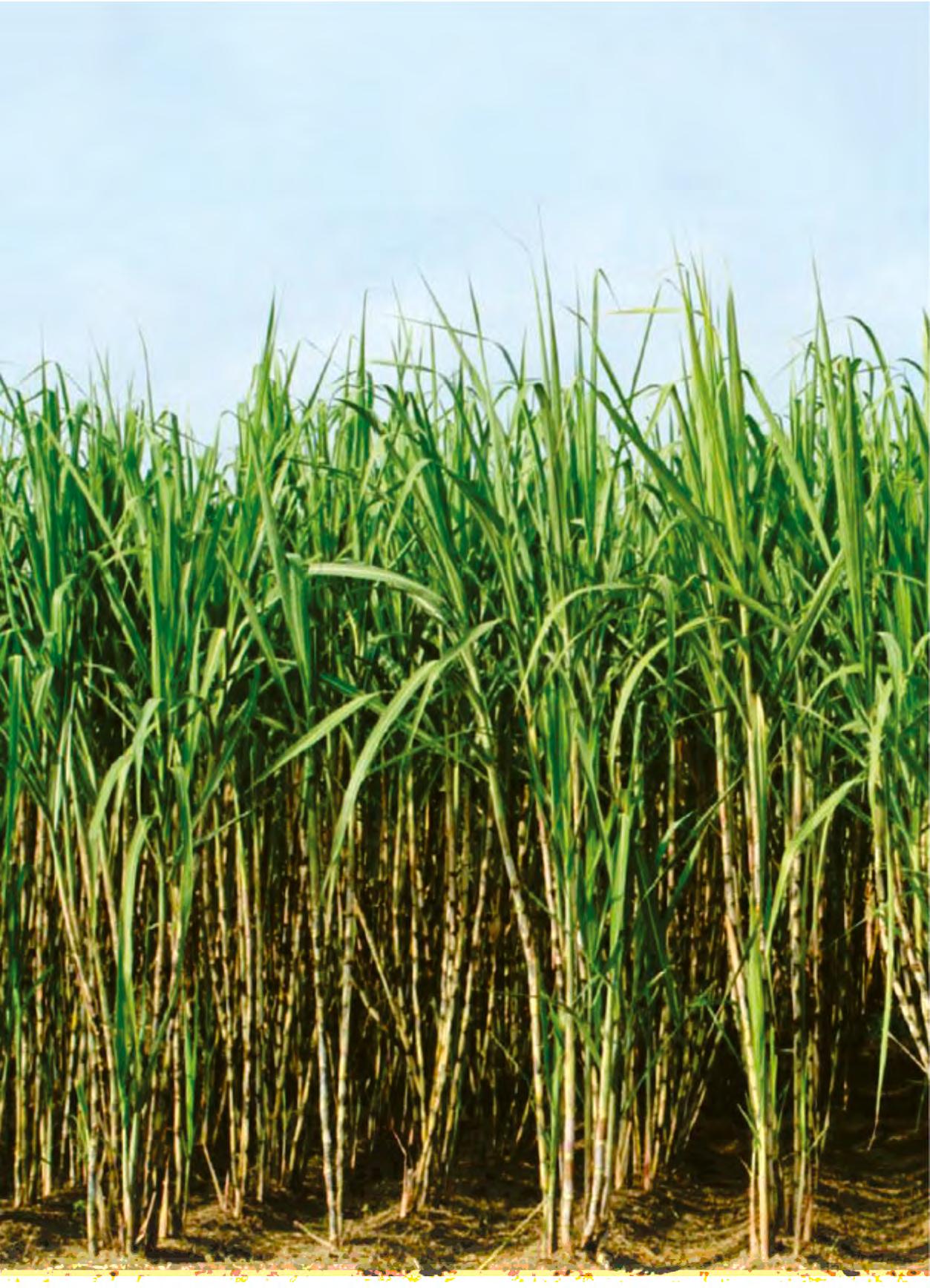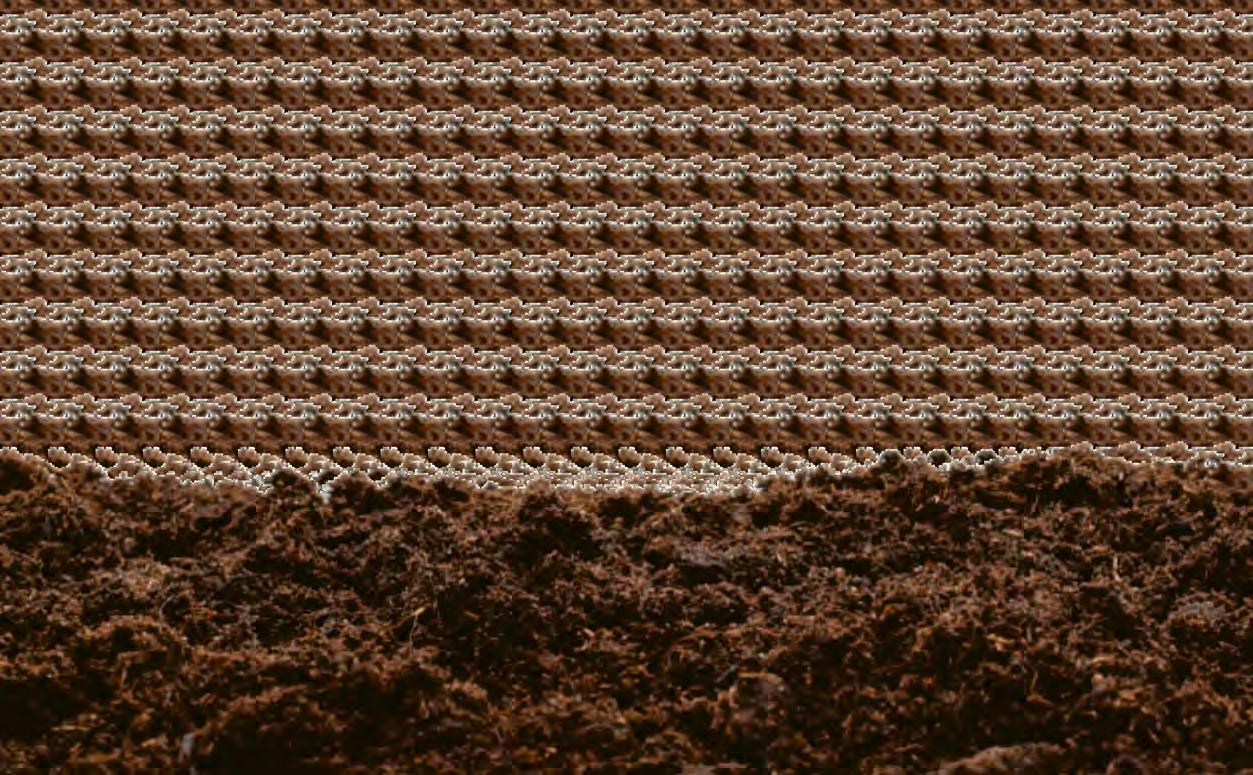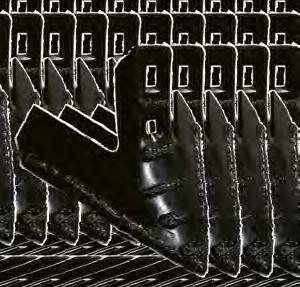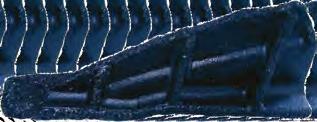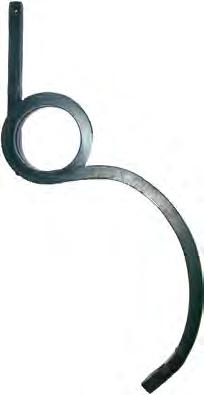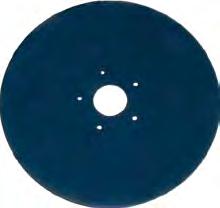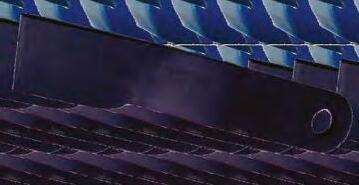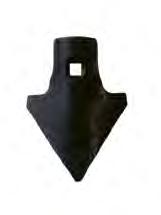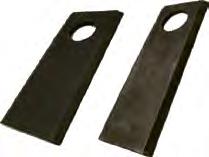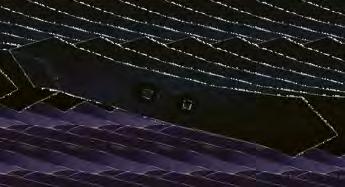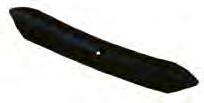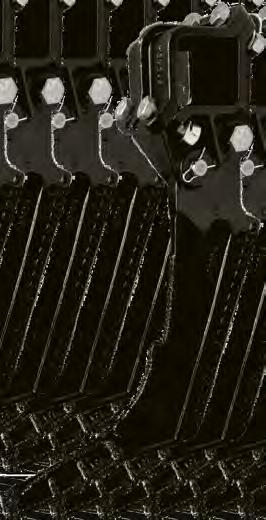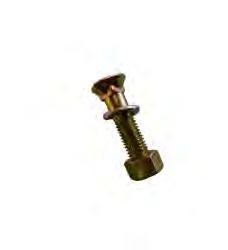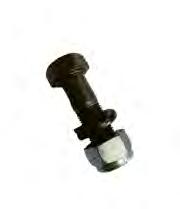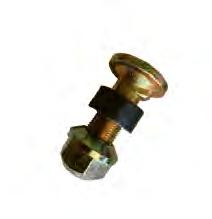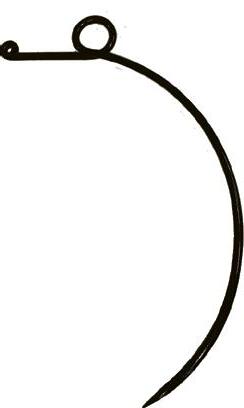








CANEGROWERS provides free crop insurance* to members. The premium is paid by CANEGROWERS on behalf of members and will cover growers against accidental fire, hail or transport related losses to their crop. This initiative is designed to give members peace of mind that their crop is covered, while also lowering operating costs for growers.



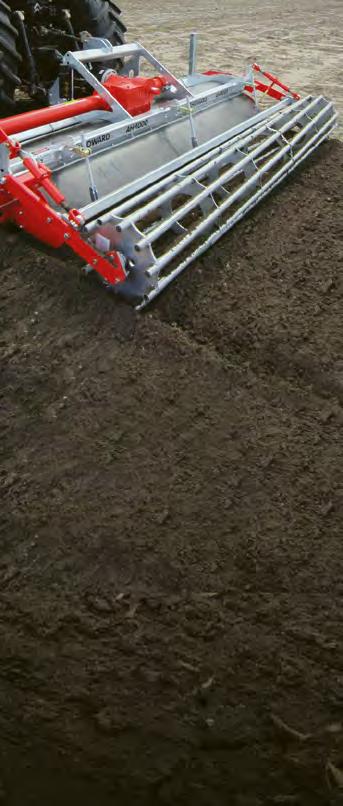
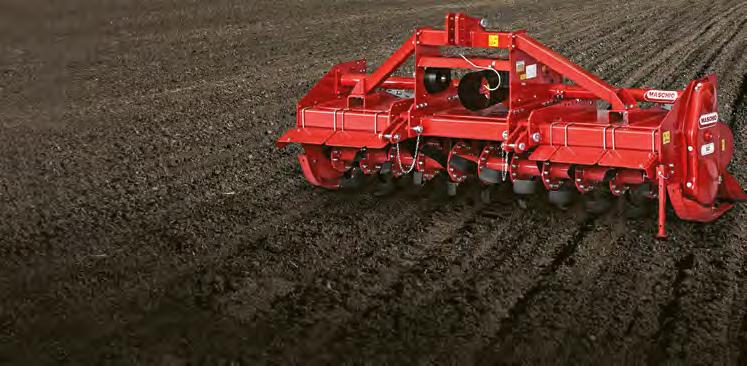
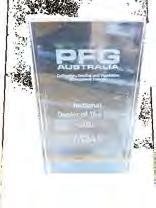
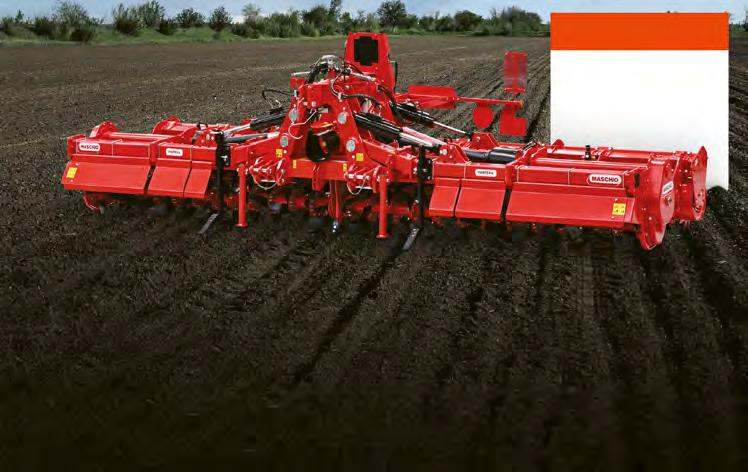

Editor: Robyn Devine
Design: Justin Fulton
Articles appearing in Australian Canegrower do not necessarily represent the policies or views of CANEGROWERS.
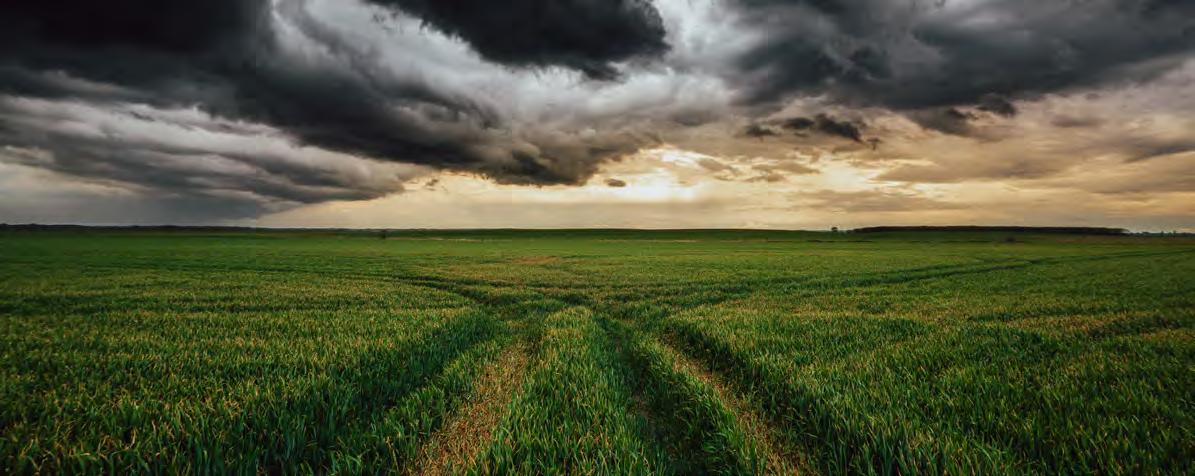
Published monthly by: CANEGROWERS, GPO Box 1032, Brisbane, Queensland 4001 Australia. ABN 94 089 992 969
Telephone: 07 3864 6444
Email: editor@canegrowers.com.au
Website: www.canegrowers.com.au
Subscriptions
Yearly subscriptions for 12 issues (postage included)
Within Australia: $176 inc GST
Overseas (AUD): $265
COVER IMAGE: Bundaberg Sugar's Millaquin Mill is just one of the assets that owner Finasucre is considering selling.
Photo Credit: ZJ Images Bundaberg
Read more on page 5
Three months after the 2023 harvest kicked off in Tully, the last Queensland sugar mill to fire up finally commenced crushing on 21 August.
Three months after the 2023 harvest kicked off in Tully, the last Queensland sugar mill to fire up finally commenced crushing on 22 August.
Rocky Point Mill was initially scheduled to start crushing on 14 July, but a series of maintenance, staffing and other issues saw that timeline pushed back.

The sound of harvesters finally roaring into life across the district late last month came as a welcome relief to local growers who have struggled to get their crop off in recent years, CANEGROWERS Rocky Point Chairman Greg Zipf said.
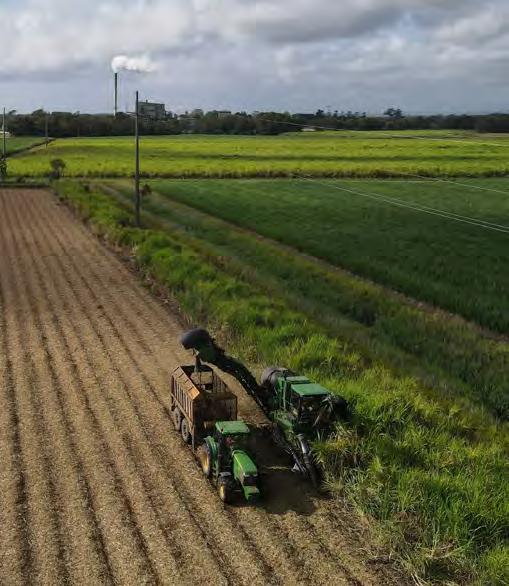
"The growers are obviously very frustrated. It's been a tough few years and everyone is hoping to get a bit of a cashflow going,"
"We have these record sugar prices, the best in 40 years, and we haven't been able to take advantage of them.
"Last year we only got half the crop off and, after a year of very little rain, probably 50% of that two-year-old cane is now dead in the stool. That's down to the near drought conditions, but also the soil types we have in many areas and the varieties, which don't seem to be well suited to standover."
Despite the setbacks in recent years, growers are relieved they still have a mill to crush cane, Mr Zipf said.
"To be honest, I'm just happy we still have a mill to crush our cane, because I think we came close to that not being the case.
"If the mill hadn't taken oover the co-gen plant in January this year, I think the previous owners would have run it into the ground and we wouldn't have a sugar industry today.
"So yes, it's frustrating and we will suffer a loss, but at least still have a mill and an industry."
A section of the Bruce Highway south of Ingham came to standstill last month, when a fully loaded haulout burst into flames on a busy Saturday afternoon.
Fire crews responded to the incident at Toobanna just after 1pm on 26 August. The Greaves haulout vehicle, which was en route to tip a load of cane, caught fire and the cab was engulfed.
Fire fighters quickly got the blaze under control and no injuries were reported. It is unclear what caused the vehicle to catch fire.
One of Australia's most iconic brands could soon be on the market, with recent media reports claiming Belgian sugar giant Finasucre is seeking $600 million for it's fully integrated growing, milling, refining, engineering and molasses operations in Bundaberg.
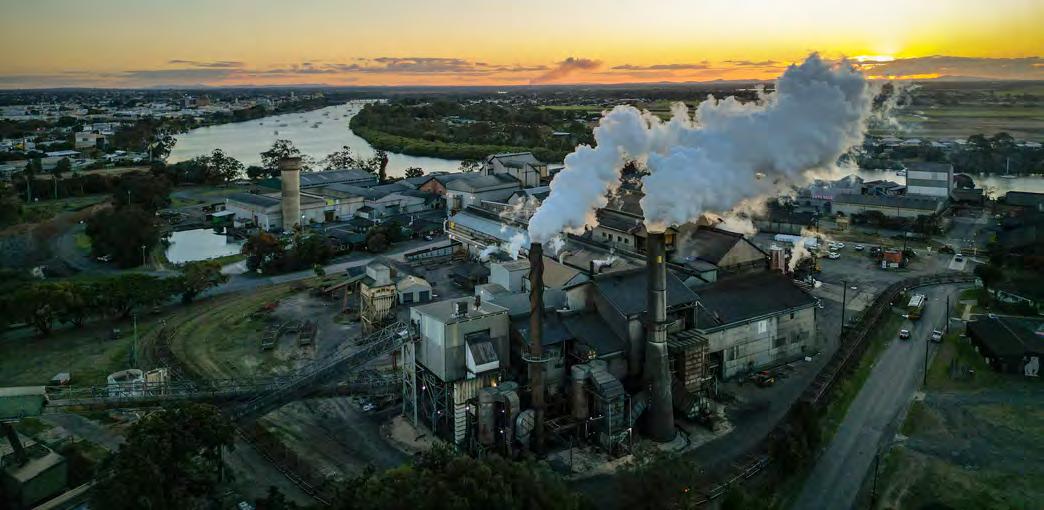
News that Finasucre was considering selling its significant assets in Bundaberg came as a surprise to many when it was revealed in a company announcement on 24 August.
Not only is the company one of Australia’s best-known brand names, it is also Queensland’s largest cane grower, in addition to being a miller and refiner of sugar.
CANEGROWERS Chairman Owen Menkens said Finasucre's announcement was sign of confidence in the industry.
"Finasucre’s decision should be seen as a sign of the strength and vitality of Queensland’s sugarcane industry and the international sugar market more generally," Mr Menkens said.
"And, if media reports are correct, it may also be a sign that outside investors are starting to sit up and take serious interest in the emerging opportunities within our industry."
According to the company's announcement, it was interest from potential buyers that sparked Finasucre's decision to investigate selling its Bundaberg assets.
The Australian Financial Review later reported that that interest had come from ' those eyeing it as a source of green energy.'
"Of course, these are only third hand reports at present and, with such a large market share of Australia’s domestic sugar
sales, it’s hard to see Bundaberg Sugar moving away from sugar production any time soon, but options exist for complimentary processing investments," Mr Menkens said. "But the fact that investors are considering the purchase of an asset worth more than half a billion dollars to produce green energy, shows just how rapidly the industry is progressing towards becoming a powerhouse of the emerging bioeconomy."
News of the sale comes just weeks after the Queensland Government announced it would earmark more than 1000 hectares in Mackay for the development of a biomanufacturing zone adjacent Mackay Sugar’s Racecourse Mill.
The industry, led by CANEGROWERS, Sugar Research Australia, and the Australian Sugar Milling Council, launched the Sugar Plus roadmap in 2021 outlining the industry’s goal of diversifying into sustainable, value-adding products such as biofuels and green energy.
"Since then, CANEGROWERS has been working with government and other industry stakeholders to make the road map a reality. We will continue that work to ensure the industry grows and thrives for the benefit of everyone in the existing sugarcane supply chain and the wider Queensland community," Mr Menkens said.
CANEGROWERS districts have been out and about within their local school communities providing handson presentations and workshops for primary and secondary students, raising awareness of the industry.
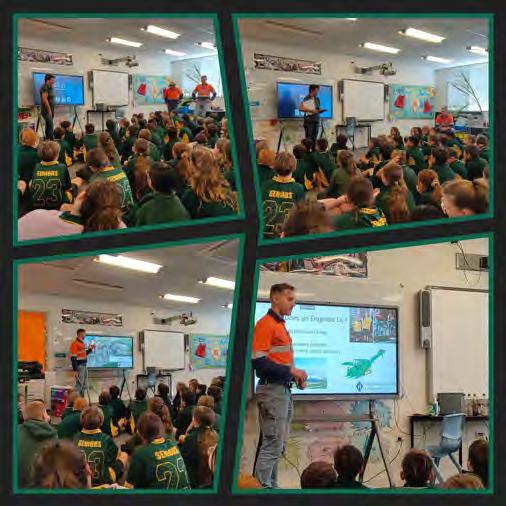

Membership Engagement and Innovation Manager Matt Kealley helped with science week activities in two schools in the Tully and Silkwood regions. The events at St John’s school in Silkwood and St Clare’s school in Tully were coordinated by Elisha La Fauci from CANEGROWERS Tully and Danielle Skojac from Sugar Research Australia (SRA).
CANEGROWERS Hebert River facilitated an agricultural workshop with students from Ingham State High School and delivery providers of the Lower Herbert Water Quality Program to increase their knowledge of technologies and farming practices to improve water quality.
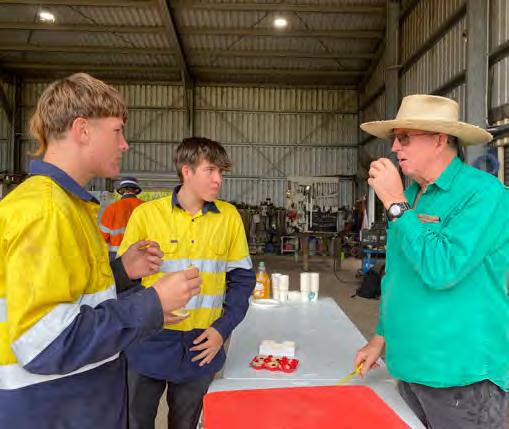
Program Delivery Providers including LiquaForce, Project Catalyst, HCPSL, TropWater, and other industry representatives from SRA and Link2Country held presentations relating to soil testing, water quality sampling, and GPS and EM Mapping.
Year 4, 5 and 6 students from Woongoolba State School in the Rocky Point district, learnt everything sweet about sugarcane at a school visit from the Keith family, operators of Rocky
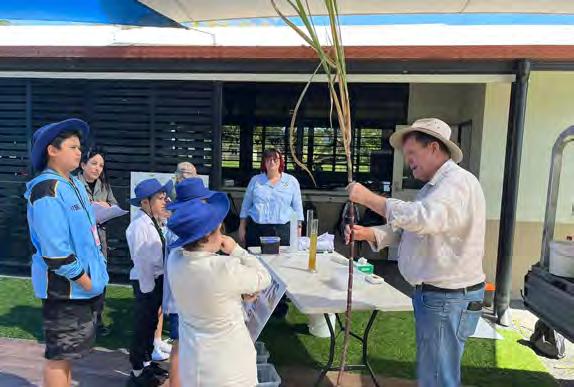
Point Mulching, and former student Kelly Heck, Process Engineer from Rocky Point Sugar Mill.
The students and staff enjoyed the presentation and explored possible career pathways for the industry.
CANEGROWERS Mackay has appointed its new chief, District Manager Michelle Martin.
Michelle comes with a strong background in business and member services, and her appointment follows the passing of esteemed, long-serving CEO Kerry Latter, who lost his battle with cancer in June.

CANEGROWERS Mackay Chairman Kevin Borg made the announcement in August, saying that a long and transparent selection process had been undertaken.
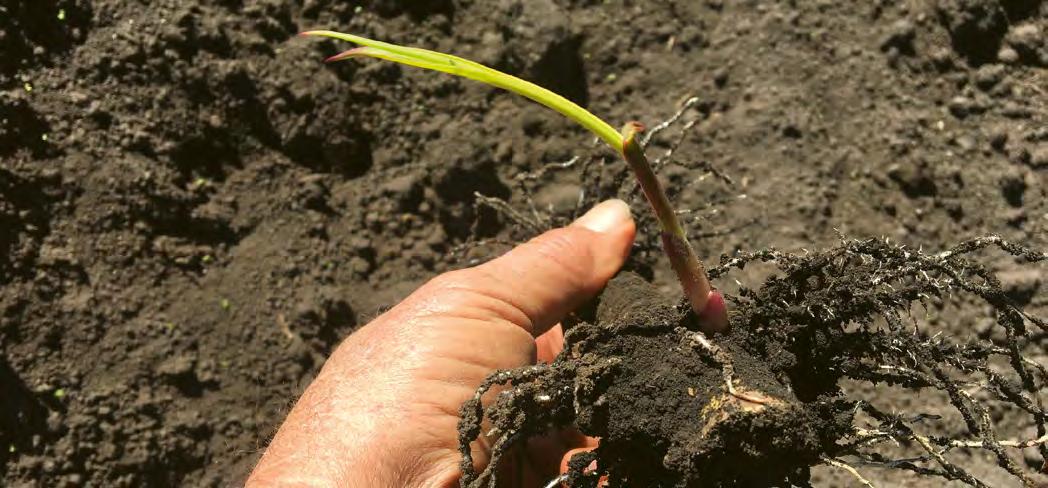
“We are pleased to announce that Michelle Martin will take on the role of District Manager,” Mr Borg said.
“She comes with a professional background in building, small business, administration, insurance, and education.
“Importantly, Mrs Martin has been with CANEGROWERS Mackay’s Grower Services for the past two and a half years, and Growers Services Manager since May 2022.
"In that time, she has had the opportunity to work closely with CANEGROWERS Mackay’s senior management and board, and has developed extensive knowledge of the industry and, with excellent relationship-building skill, has a great rapport with the membership, making her a perfect fit for the role.
“We are confident that she will bring the clear and strong advocacy for our members, and for the sugar industry as a whole, that both the community and our membership expect. We are confident that the organisation will be in good hands.
Visitors once again flocked to the sugarcane industry stand at the Royal Queensland Show (The Ekka) in Brisbane.
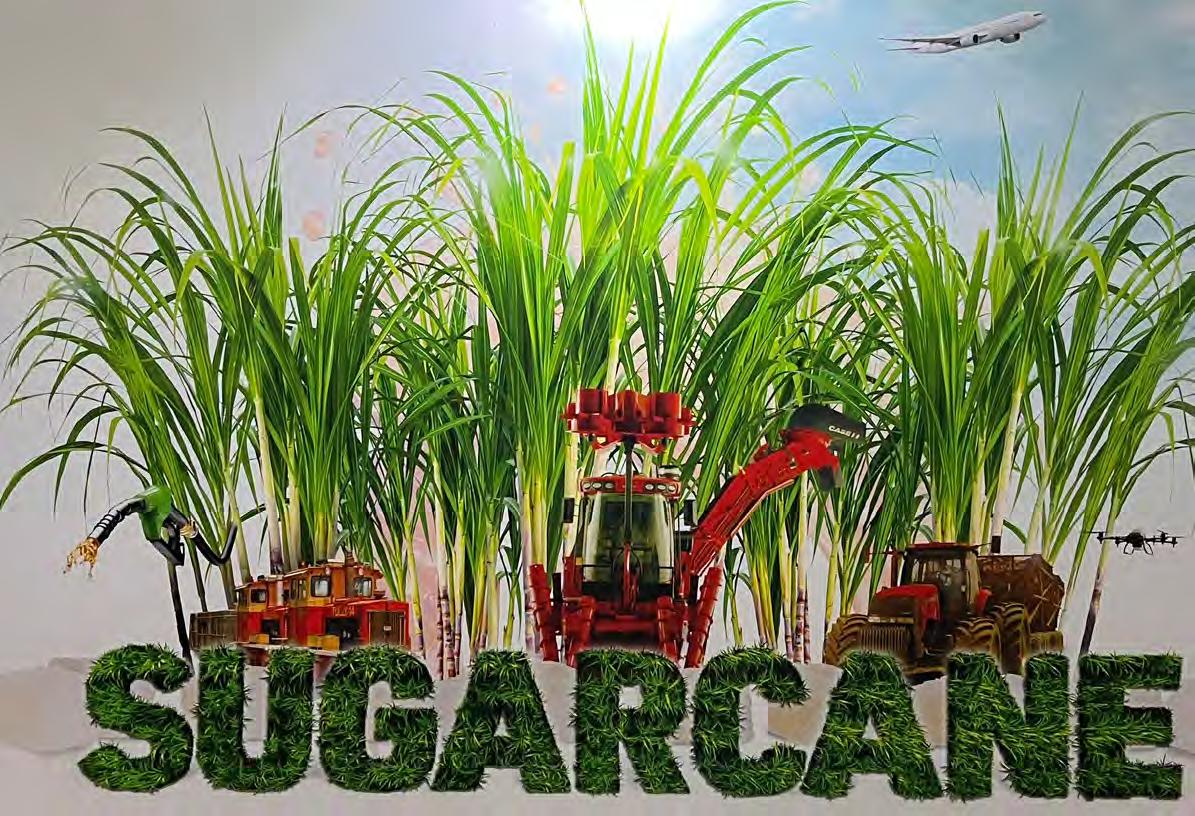
The stand, which CANEGROWERS hosted in conjuntion with Sugar Research Australia and NSW miller Sunshine Sugar, let visitors see and touch real, live cane, as well as billets, bugs and bio-products.
A specially produced Ekka magazine shared positive stories and information about the industry, including our proud history and the bright and innovative future ahead. An immersive and educational virtual reality experience
took participants on a journey through the industry, from the 'Paddock to the Packet'.
It is estimated that more than 8,000 visitors passed through the stand and feedback was inspiringly positive.
Pictured left: The QFF function at the Ekka put agriculture into the limelight and provided an important chance for CANEGROWERS CEO Dan Galligan to network with Federal and State Agriculture Ministers along with other industry stakeholders
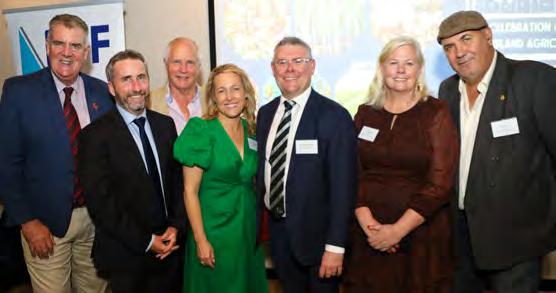
Pictured on the opposite page top left: Young growers Jacob Camilleri and Jessie Borg from Mackay popped in to say hello.
Top middle photo is the Attard family from Bundaberg who spent some time at the stand. Many school students took advantage of the the VR experience and the live cane grubs from SRA were also a big hit.

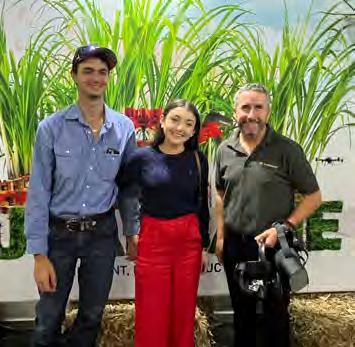
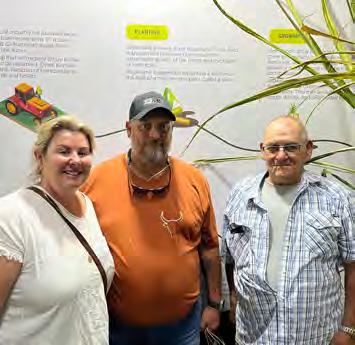
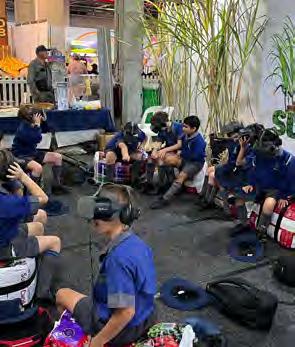
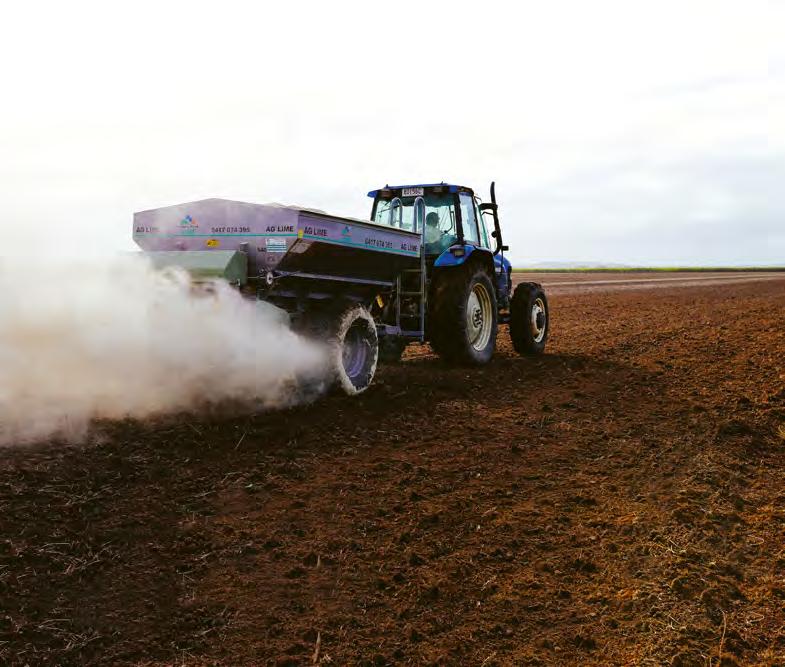
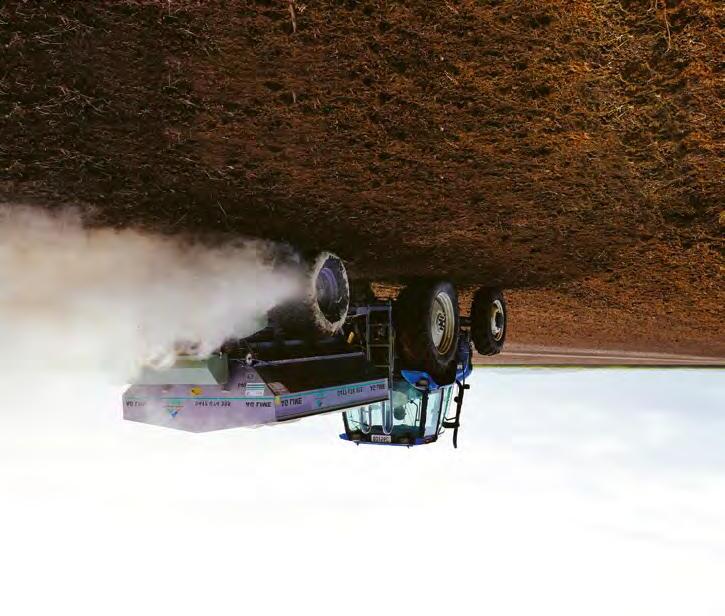
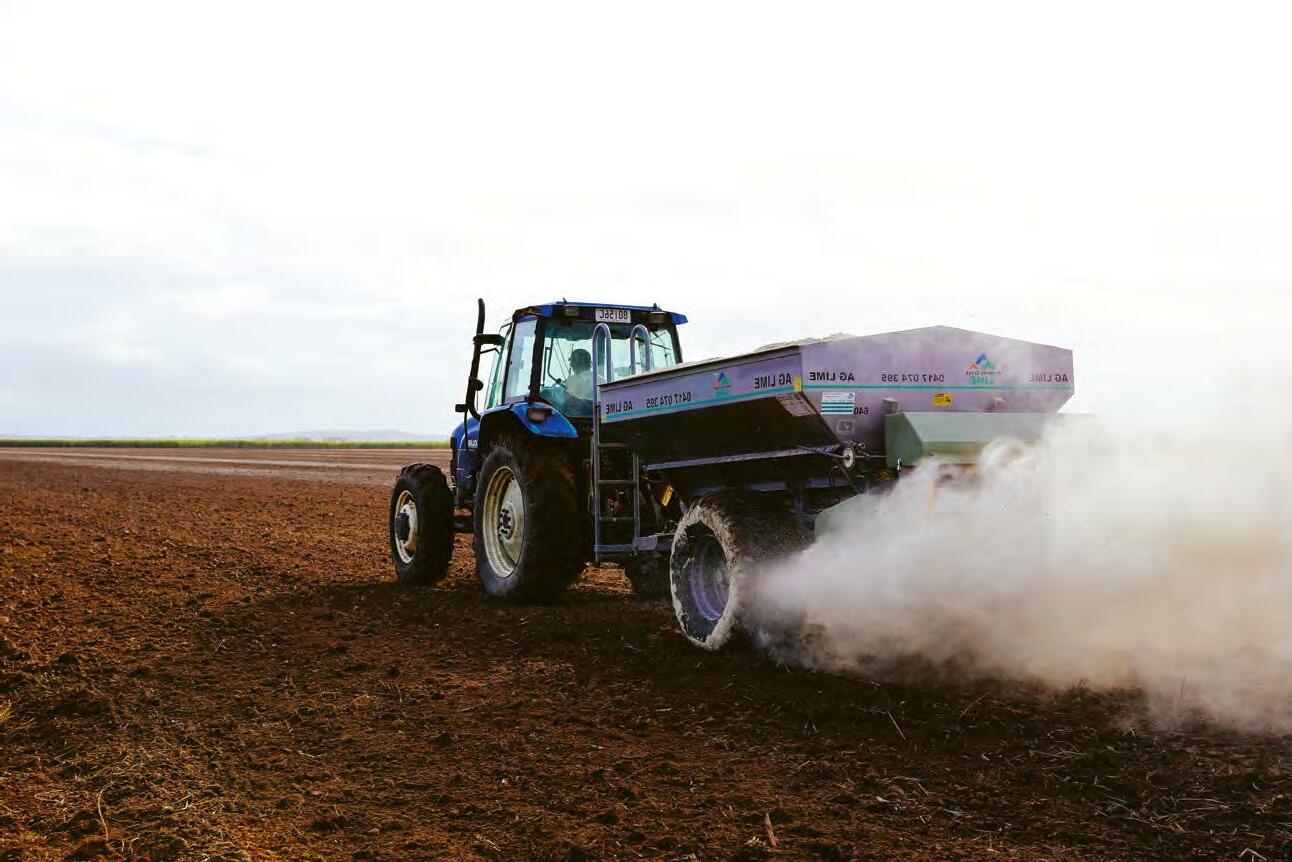

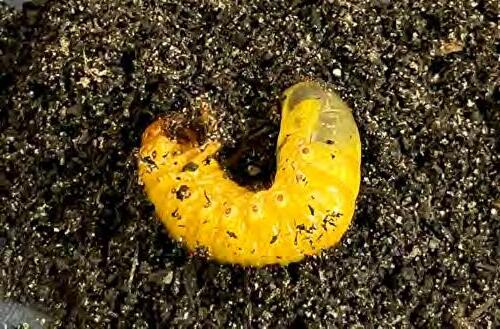
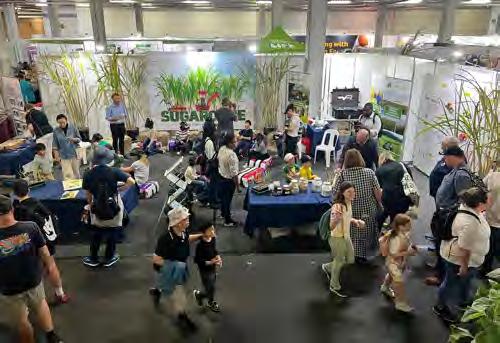

You don’t have to be political scientist to detect a shift in the atmosphere around Queensland state politics. The next state election is just 12 months away. It is the first election to be held since the introduction of four-year fixed terms and you can literally see the deck chairs being manoeuvred by the major political parties as they work out the team that will put them in the best position to either retain or win government.
It is almost as if they have itchy feet as they reach the traditional three-year mark of the current electoral cycle. A year seems like a long way away, but the nature of political advocacy is that the earlier you begin, the better chance you have of achieving the outcome you want.
CANEGROWERS has been advocating on industry policies since the day after the 2020 state election. Successful advocacy is built on relationships. Relationships at the highest level with the Premier, Cabinet ministers and local members of parliament, right through to senior government officials and party or union officials.
CANEGROWERS has, over many years and with the help of our extensive regional and national connections, forged relationships at each and every one of these levels.
Many of the agricultural industry issues are not new, they relate to planning policies, biosecurity, agricultural research and development, water and electricity pricing, and state development.
But, as it will have been four years since the last major opportunity to obtain public election policy commitments from an incoming government, an election campaign is a critical point in time for change in policy.
Across all these policy issues there has been enormous, rapid change - sometimes an evolution, sometimes a degradation of the role of farming.
The Queensland election landscape is very unique. Labor has been dominate since 1989, when the
party came back to power after an extraordinary thirty-two years in opposition.
Since '89 they have held power with just two spells in opposition in 1996–98 and 2012–2015. Queensland has had a Labor government for 30 of the last 35 years with Premier Palaszczuk dragging them from opposition to government in 2025.
Factually, any government having spent eight years in power will come under significant pressure. The history shows that LNP opposition still needs to make a case for change and demonstrate their vision for Queensland.
Furthermore, particularly in our very important regional seats, we have many very effective and very relevant “minor” party and independent members of parliament who could very easily find themselves determining who forms government. The position of these MPs in the Queensland parliament is too important to ignore.
So even though it is 12months out, the political jockeying is well and truly underway.
While the industry and growers are rightly focused on this year’s harvest, the staff at CANEGROWERS are well into the process of working with our colleagues at the Queensland Farmers’ Federation and their other 20 industry members to establish a very strong, very positive and very specific election platform.
We will work together to make the voice of farmers heard in this campaign and make sure politicians who want to make a mark on the state, start by showing their support for agriculture.
Proven in Australian conditions, the CH9 Series Sugar Cane Harvester features two independent front feed systems and basecutters that allow you to operate at a similar speed as single-row units, while dramatically multiplying your capacity – a true two-row. So that’s fewer hours spent harvesting, labour savings, reduced fuel costs, and less soil compaction. Plus, the redesigned cleaning system and wider chopper, coupled with our smart technologies including RowAdapt™, means billet losses are reduced by up to 50%1 Multiply your operation’s performance. Talk to your local dealer today.
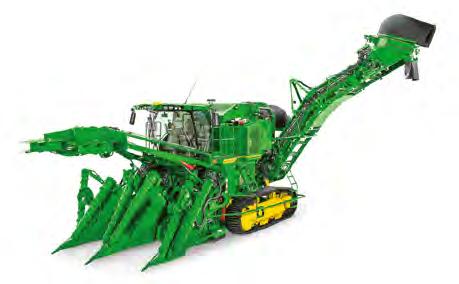
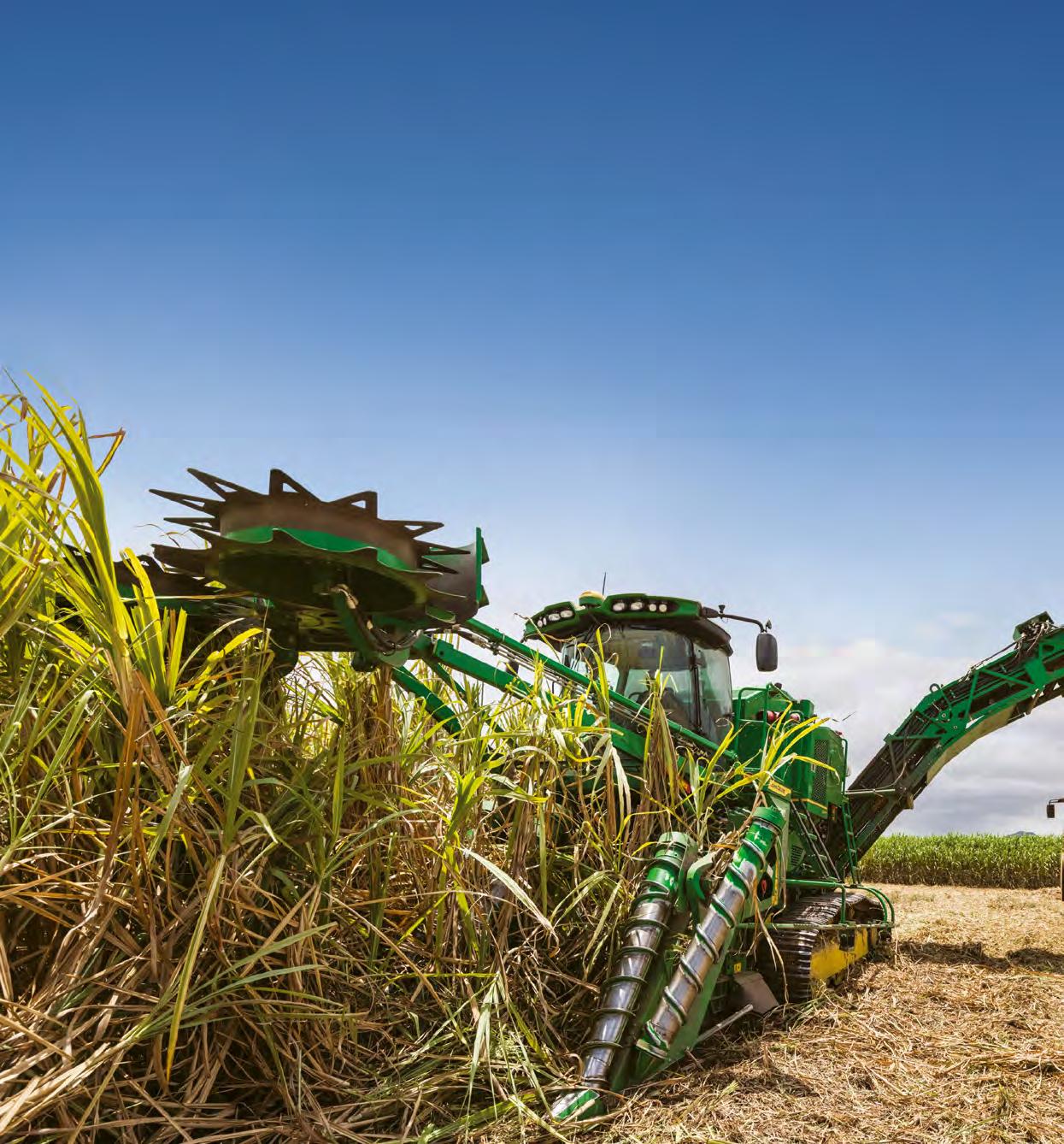
Kate Reardon commenced as the Smartcane BMP Program Manager in early August and along with CANEGROWERS Sustainability Manager Mick Quirk will be visiting the districts in the coming months. Australian Canegrower caught up with Kate to find out how she was settling into the role.
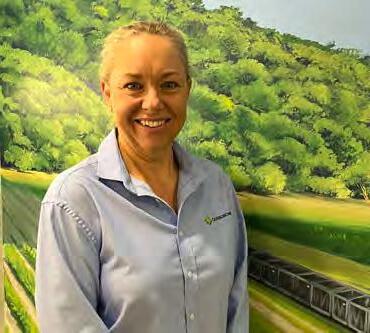
As the new Smartcane BMP Project Manager I am honoured to support the industry in highlighting your stewardship of the environment and willingness to protect the land you farm on and the surrounding environment. Together we can ensure the program continues to meet community expectations, is the benchmark for Australian sugarcane accreditation, and drives innovation, sustainability, and profitability in the sector.
Until now North Queensland has been absent from my work destinations, I am looking forward to visiting all the regions, meeting, and learning from all involved in the sugar industry. Starting in a new commodity is both exciting and frightening, as it provides insight into another arm of the agricultural industry and introduces you to the characters who drive it.
Born and bred on a mixed grazing farm in North West NSW, my sugarcane knowledge was the burning cane fields of the 90s Coca-Cola ads. I am grateful to have spent nearly my entire career in this incredible industry riding the waves of the highs & lows, learning growers are a resilient bunch of diamonds shining under the pressure of feeding the world.
Most people tend to cock their heads to one side with a puzzled look on their faces trying to understand how I work in agriculture in the city. These moments provide an opportunity to educate the urban resident on the value agriculture brings to Australia’s economy. Whilst the rural lifestyle I grew up in is not for me, spending time in the field with those who do ignites the passion from within to ensure the industry is being heard.
Like most farm kids, I learnt to drive the moment my feet touched the pedals & slowly upgraded to other farm transport as I grew older, my career has been no different. I have spent time in multiple agricultural industries, including chemical, horticulture, economic development, and recently hybrid seed.
Each role has gifted me an education in farming practices, on-farm innovation, and intimate knowledge of the workings of a wide range of agricultural industries throughout Australia.
My career has enabled me to travel nationally and internationally, to see firsthand Western Australian farming operations growing profitable crops in the sand to large-scale intensive dairy systems in New Zealand. Growers’ ability to adapt to changing circumstances, uncover innovative techniques to provide solutions and adopt efficiencies from non-related industries continues to amaze me and I often reflect on how far the agriculture industry has advanced.
The ag industry has provided so many enjoyable moments, from near misses with forklifts in produce markets attempting to get away from those who were chasing me down, wanting to know what I was selling and who was selling it; to being caught bogged on a major highway by a key client as I attempted to put a crop sign on his crop. However, it is those who live and breathe this industry that keep me here. There are so many colourful characters, who always have a story to share or teach you something incredible.
"The ag industry has provided so many enjoyable moments"
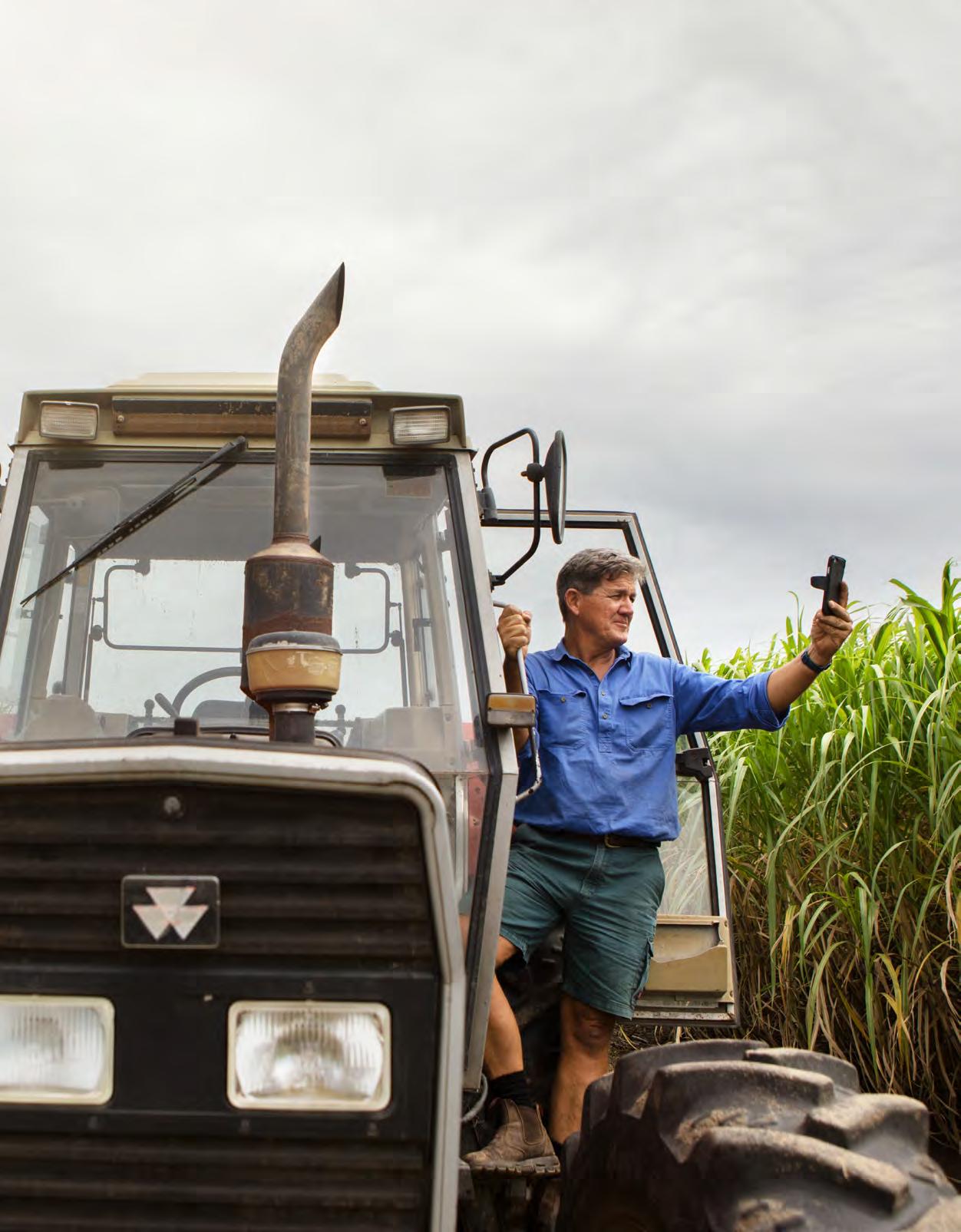
out the end dates again.
The northern and central districts are well behind on their planting, and this will push things back for next year’s crop. Well may we ask - where is the predicted El Nino?
At our last policy Council meeting on Wednesday 26 July, Meteorologist Lauren Murphy and Agriculture Segment Lead Rachel Davis from the Bureau of Meteorology (BOM) provided a presentation on weather forecasting and the available BOM platforms and tools.
At that time the El Nino had not been declared by BOM, mainly because of higher temperatures in the pacific which in turn led to the unseasonably high rainfall in July.
Weather forecasting inaccuracies were also discussed by Council members and who asked why the previous rainfall event wasn’t predicted accurately in some districts.
Essentially, the longer-range forecast (up to 7 day) requires measurements using weather balloons in western Queensland. These measurements help BOM to predict the direction and strength of the event.
It is understood that BOM needs more funding from government to put more of these balloons up.
CANEGROWERS, through our relationship with the agricultural segment of BOM, will investigate getting more funding to increase the accuracy of these predictions.
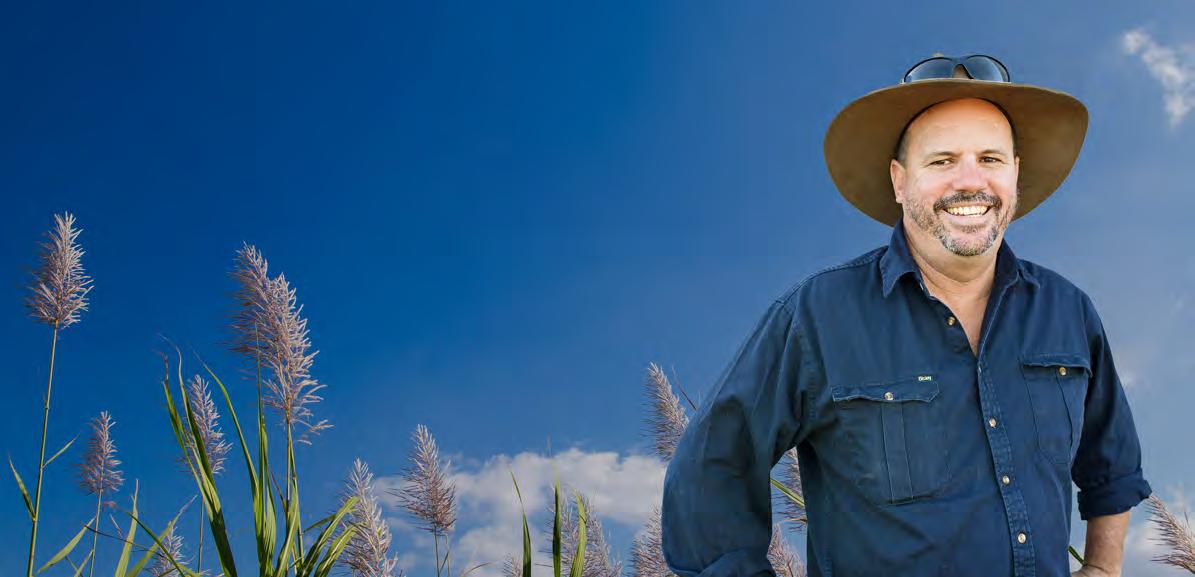
It is ironic that BOM is underfunded even though climate change is topical and meant to be the “moral issue of our time”.
Accurate weather prediction is fundamental for growers, especially as we have the Reef regulations as well as spraying label rules.
Growers need to be sure that rain is not about to fall when applying chemical or fertiliser.
The real issue is making sure heavy downpours of more than 50mm are not missed by forecasters.
There should be funding available through some of these Reef programs, after all, this is a Reef protection issue.
The appropriate timing of chemicals and fertiliser application regarding the weather forecast is essential to the health of our coastal ecosystems.
Therefore, government Reef programs should be funding an improvement in weather accuracy.
Hopefully going forward, we will see more funding in this area to help cane growers go about their business.
In other news it was great to see the fantastic reaction to the CANEGROWERS Ekka stand. I would personally like to thank all the Brisbane staff for the work they put into staffing the stand. I would also like to thank our key partners in this activity Sugar Research Australia, NSW based Sunshine Sugar and the Rocky Point growers for supplying time and products for the stand.
The Ekka is a great opportunity for our industry to put a positive message about ourselves to city kids and their parents.
It is good to see we are finally starting to get some dry weather across the state. It has been a wet start to the crush for most districts which has slowed progress and pushed

Since 1981, Dr Robert Magarey has dedicated his career to sugarcane pathology, becoming the country’s foremost authority on diseases that affect the plant, and how to manage them.
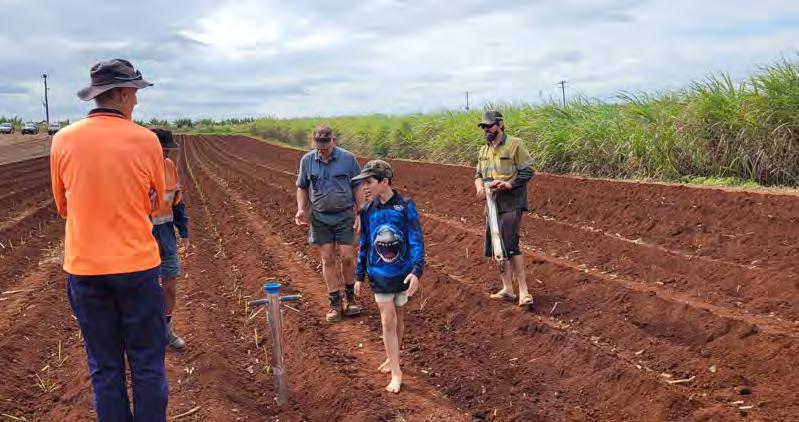
His work has ensured the Australian sugar industry has survived and thrived, helping to identify and deal with the ever-present threat of disease, such as the incursion of smut in 2006 and the discovery of the pathogen which causes Pachymetra root rot.
Known by industry insiders as simply ‘Rob’, his commitment may be considered even more remarkable given he had no ties to sugarcane production until he finished his tertiary education.
“I grew up on a pear, apple and stone fruit orchard in the Adelaide Hills,” Rob told Australian Canegrower. “So, I had an interest in agriculture and I did a four-year Agricultural Science Degree at the University of Adelaide. Then I completed an honours project on brussels sprouts for another 12 months. When I finished, there were no jobs in agricultural science in South Australia.
“Colin Ryan, who was to become Director of BSES, the pre-cursor to Sugar Research Australia (SRA), contacted the University of Adelaide
and said there was a job available, and did they have any candidates?
“I received a phone call asking whether I would like to apply for that job, or a job with the Department of Primary Industries in Queensland, which was also looking for a plant pathologist. I applied for both.”
Despite the stars seemingly being stacked against him, Rob made the move to Queensland soon after.
“I drove to the airport to catch the plane for the job interview and immediately realised I’d locked the keys in the car. Anyway, I got on the plane which was supposed to fly to Sydney, but it was diverted to Canberra because of fog. After waiting for the fog to clear, I made it back to Sydney but missed the flight to Brisbane.
“I managed to get on a later flight but when we got to Brisbane a light plane had crashed at the airport so we had to circle awhile before we landed. By the time we landed and I made it to the BSES office at
"Anything we found out was new and we became world experts overnight”
Plant pathologist Dr Robert Magarey is being farewelled after more than four decades at the leading edge of sugarcane science.Rob Magarey tissue culture planting with growers in the Innisfail district July 2023
Indooroopilly I was so late they thought I’d stopped in Sydney for another job interview and were reluctant to interview me.
“Thankfully they did, but halfway through someone came in and said the pilots were going to strike so they wanted to get me on a plane. The only place they could get me to was Melbourne. I walked out of the interview and spoke briefly with the DPI person then went to the airport and caught a plane to Melbourne.
“I’d been from Adelaide, to Canberra, to Sydney, Brisbane and Melbourne in one day and when I tried to get on the bus back to Adelaide the next morning, I missed it because the depot wasn’t answering the phone.
“When I eventually arrived, I had to get the RAA (SA’s equivalent to RACQ) to come and unlock the car. I then got into trouble with my football coach because he didn’t know where I was. At the time I was playing Australian Rules football in the Adelaide competition.
“In the end it was all worth it because I was offered both jobs and that was the start of my time with BSES/SRA.”
Already engaged to be married, Rob spent two weeks at his new job in Brisbane before returning to Adelaide for the wedding and returning with his new bride, Sue. He transferred to the Tully Station in 1984.
Rob’s initial working years proved to be a steep learning curve due to a mysterious cane condition affecting the Babinda and Innisfail Districts in the 1980s.
“When I joined, Pachymetra was severe and there was a lot of industry pressure on us to find out what was going on,” Rob said. “I was part of a multi-discipline team that was working on this poor root condition. It was my colleague Barry Croft who was the first to isolate Pachymetra. He looked at the resistance of varieties and I looked at developing an assay and other forms of management.
“It was new to science, it was undescribed, it had never been given a name. Initially we just referred to it as the root rot fungus.
“Anything we found out was new and we became world experts overnight.”
Other major challenges to follow included the outbreak of orange rust in the Mackay and Herbert districts at the turn of the century and the incursion of smut within the same decade. “Roughly 90% of the Mackay District was cropped to one variety and the orange rust pathogen mutated and almost immediately the canopy of every crop turned brown and it was a dreadful situation because they didn’t have much other planting material,” Rob explained.
“Of course, smut came along six years later, so it was a big challenge working with industry to transition to new varieties. If you grow one variety that dominates a mill area for five to ten years straight, it really is risky business.”
During the course of his career, research projects have taken Rob to the birthplace of sugarcane, Papua New Guinea, as well as to Indonesia and China. He also has close contacts in the USA and in Europe.
Rob says safeguarding the Australian industry from biosecurity risks is paramount.
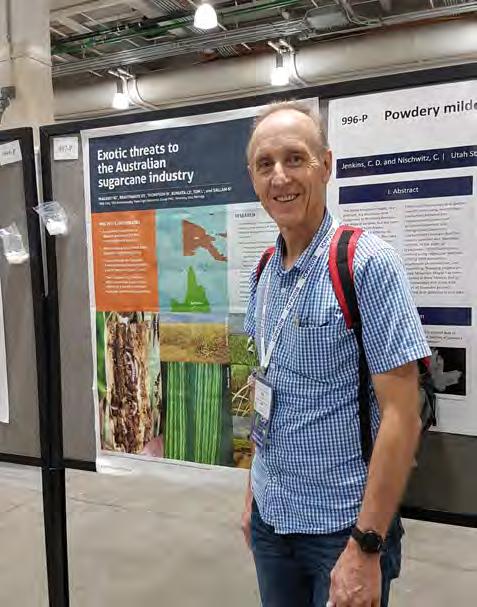
“We can’t wait for the horse to bolt before we shut the gate, we’ve got to be prepared.”
“If you have smaller areas with rotation crops, a biosecurity issue will only take out a small part of the business but in cane if a biosecurity threat arrives, growers’ whole income is threatened,” he explained.
“There’s also high possibility of entry because sugarcane is grown over such a large area. To the north of us, including in the home of sugarcane, there are threats that are just a hop, skip and jump away.
“We can’t wait for the horse to bolt before we shut the gate, we’ve got to be prepared.”
Throughout his career, Rob has worked closely with growers right across the sugarcane regions of Queensland and New South Wales, with in-field trials vital to his research.
“I’ve really enjoyed working with industry,” he said. “There have been some farmers who I’ve had very close contact with.”
He’s also served as presidents of both the Australasian Plant Pathology Society and the Australian Society of Sugar Cane Technologists.
Rob’s dedication to the industry saw him recognised with the 2023 Award for Excellence in Agricultural Research at the prestigious Kondinin Group and ABC Rural Australian Farmer of the Year Awards.
Yet he still has unfinished business, including seeing through a new project involving the detection of Ratoon Stunting Disease at mill level and the pending eradication declaration for Fiji Leaf Gall.
“There are always things to finish,” Rob said. “You’ve got to retire some time, I’m not going to live ‘til 150.”
Rob’s now looking forward to spending more time with his family - including 16 grandchildren – and restoring his second Model T Ford. He’ll also continue to pastor at churches in Tully and Mission Beach.
Tully cane grower and Chairman of Tully Cane Productivity Services, Gerry Borgna, has worked alongside Rob Magarey on various research projects for around four decades.

“He’s world renowned,” Gerry said. “As the only dedicated sugarcane pathologist in Queensland, Robbie has spent a lot of time travelling all up and down the coast and he made meeting with industry a priority,” Gerry said.
“He never beat his chest; he worked behind the scenes to just get things done.
“He has helped the industry cope with potential and actual incursions of disease from neighbouring countries by frequently visiting sugarcane regions overseas to know everything there is to know about biosecurity risks.
“Nothing was too much of a problem for him and he’s very cooperative. You could ring Rob up if you had a leaf problem or a condition you weren’t sure about and he would come out. I guess we’ve been spoiled because he was based in Tully. He’s a real community operator.”
Seona Casonato is SRA’s new Leader Field Pathology, also based at the Tully Station. Seona completed an applied science degree in horticulture at the University of Melbourne before securing a scholarship to RMIT University to complete honours followed by a PhD in weed biological control.
Over the course of her career spanning more than two decades, Seona has worked with all manner of plants from cut flowers to kiwi fruit, bananas, onions, wheat, barley and more.
Your Trusted Partner
Current as at 15 August 2023.
Influence Commentary Outlook
Brazil
Harvesting in Centre South Brazil continues at a record pace and has appeared to overcome initial fears of logistical port issues. By the end of July 311 million tonnes of cane had been crushed and 19.2 million tonnes of sugar produced.
After a late arrival, the Indian monsoon has progressed at varying speeds and is now roughly in line with long-term average rainfall. Concerns over how much sugar the government will allow to be exported under the export quota are rising.
Thailand experienced extremely dry weather and heatwaves throughout June which is likely to inhibit cane growth. Monsoon season rain arrived in July, however, is expected to be up to 10% below average for the year. Speculators
Speculators reduced their net long position to 111,000 lots as of 8 August providing a virtually unchanged month-on-month figure. Neutral

The AUD fell to a fresh yearly low of 64.54 US cents following the RBA leaving rates on hold while the US Federal Reserve raised rates again in July. Fears of a struggling Chinese economy, which is battling deflation, dragging down the Australian economy has also weighed heavily on the AUD.
The outlook ratings above are in relation to AUD/tonne sugar prices. A bullish outlook is considered positive. A bearish outlook is considered negative.
The highest grower-managed pricing levels achieved across all growing regions using QSL products to date (all gross price actual/tonne) are:
• 2023 Target Price = $850 / IFC $875 (Jul23)
• 2024 Target Price = $725 / IFC $750 (Jul24)
• 2025 Target Price = $645 / IFC $650 (Jul25)
• 2026 Target Price = $610 / IFC $610 (Jul26)
Key Dates:
• 20 September: Last day to price 2023-Season Target Price Contract tonnage before the pricing window is automatically extended and roll adjustments apply.
• 20 September: Last day to achieve or roll pricing allocated to the October 2023 ICE 11 contract through the Individual Futures contract or Self-Managed Harvest Contract.
• 31 October: Last day to nominate QSL as your sugar marketer for the 2024 Season.
This chart captures
pricing achieved
of 15.08.23 by growers from across all sugarcane growing regions using QSL’s Target Price Contract, Individual Futures Contract and Self-Managed Harvest products. Prices quoted at AUD/tonnes actual gross.
Disclaimer: This report contains information of a general or summary nature and is based on information available to QSL from many sources. While all care is taken in the preparation of this report, the reliability, accuracy or completeness of the information provided in the document is not guaranteed. The update on marketing and pricing activity does not constitute financial or investment advice. You should seek your own financial advice and read the QSL Pricing Pool Terms, which are contained on QSL’s website. Nothing contained in this report should be relied upon as a representation as to future matters or that a particular outcome will be achieved. Information about past performance is not an indication of future performance. The information in the report is current as at the time of publication and is subject to change, as the information is based on many assumptions and is subject to uncertainties inherent in any market. QSL does not accept any responsibility to any person for the decisions and actions taken by that person with respect to any of the information contained in this report.
all
as
Herbert Cane Productivity Services Ltd (HCPSL) recently invited staff from Animal Control Technologies Australia (ACTA) to view firsthand the impact of rats on the current cane crop and the effectiveness of RATTOFF®.
ACTA and HCPSL staff inspected fields across the district on Wednesday 9 August, where RATTOFF® had recently been applied, to view the efficacy of the product and its impact on rat populations.
Upon inspection of treated blocks, sachets were found to be opened by rats and there was a significant decline in rat damage of the treated blocks.
RATTOFF® contains zinc phosphide coated grain which is quite stable while kept dry in the original packaging.
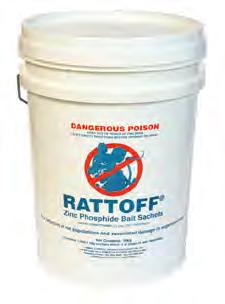
Once the rat eats into the edible sachet it can take 3-5 grains of poisoned wheat, then the chemical quickly

reacts with its stomach acids to produce poisonous phosphine gas in the gut area.
As there is enough product in each sachet to kill up to 50 small rats, so it is common for bait to be left over and some sachets to remain unopened even when the rat population has been reduced. These sachets continue to control any new rats entering the baited area after initial knockdowns.
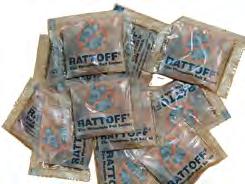

Often, rats will drag the sachets back to their nests. Not only does this remove the sachets from above the ground but it also delivers the product directly to the colony.
The RATTOFF® sachet consists of a cellulose membrane that is water resistant, but which breaks down over time due to UV light (usually occurring after a few weeks). The sachet protects the treated wheat grains in the event of rain.
Research tested the effects of additional attractants to improve RATTOFF® uptake by rats. The trial results were non conclusive but found in some cases that the addition of linseed oil did improve uptake.
ACTA and HCPSL staff also inspected young ratoon crops and found significant rat activity in these blocks. Growers are urged to start controlling rats in these crops to avoid carry over to next year’s crops.
Zinc Phosphide Bait
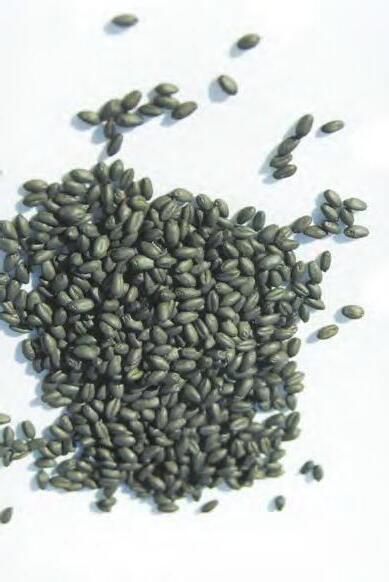
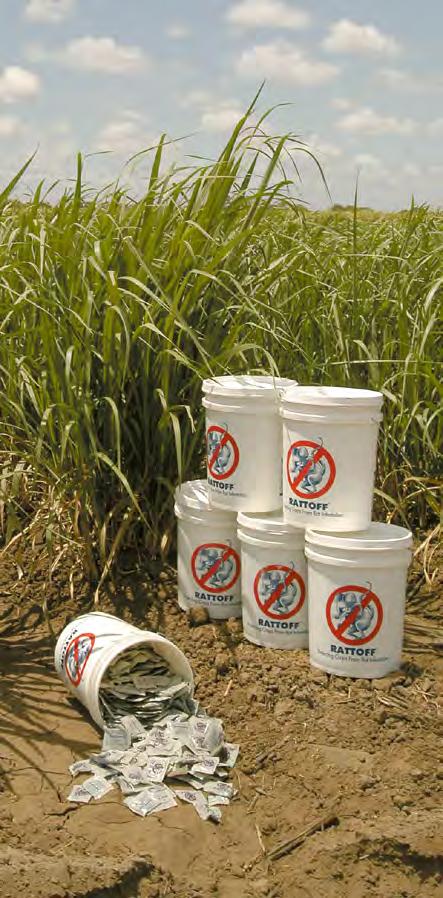
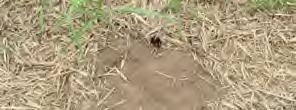
RATTOFF® bait sachets provide a cost-effective and environmentally safe method for rodent management in standover cane, where a major rat risk to cane yield is emerging.
APVMA have issued a permit to Cane Growers in Ingham and Mackay to allow helicopter or drone application at 1kg/ha in standover cane where ground access is impossible.
RATTOFF® stocks are available at most major rural retailers in affected regions.
Animal Control Technologies
Australia Pty Ltd
Phone: 03 9308 9688 Fax: 03 9308 9622
Email: enquiries@animalcontrol.com.au
More info at www.animalcontrol.com.au
When treating a field, two applications of RATTOFF® may be required. The first application will target those rats above ground, not the lactating mothers and their young that are in borrows. A second application is sometimes required approximately 6-8 weeks later when these lactating mothers and the new juveniles come to the surface to feed.
Growers should monitor the blocks to see if further applications are required. RATTOFF® is registered for use in

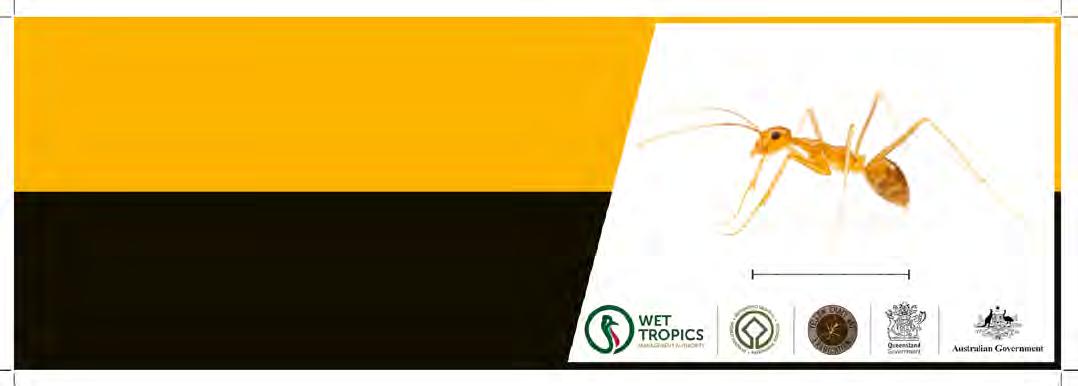

sugarcane crops using ground and aerial application are allowed under APVMA permit by drone or helicopter. The recommended application rate of the product is 100 sachets per hectare or a total of 1kg of bait material per hectare.
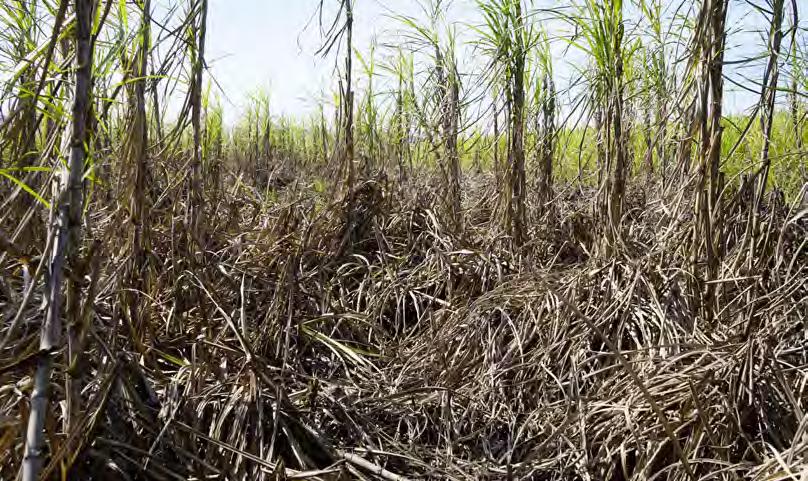
There are only two registered products i.e., RATTOFF® and Racumin approved for control of rats in sugarcane crops. Other anticoagulant baits are not approved for use in sugarcane because they pose a risk to wildlife and
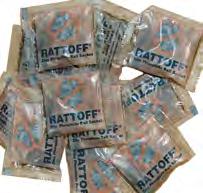
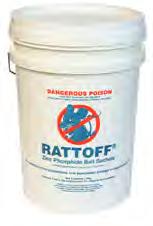
persist for long periods in most animals.
An Integrated Pest Management (IPM) program should be considered to reduce rat numbers. Rat baiting is only one tool in a farmer’s toolbox when other measures are not effective in managing rat population numbers. As a part of an IPM program consider the following: managing weeds in crops, drainage lines and riparian areas by mowing, spraying and revegetation of habitat areas.
For more information concerning the management options of rats please contact ACTA on 03 93089688 or refer to the ACTA website www.animalcontrol.com.au

The Wet Tropic Management Authority (the Authority) is pleased to welcome Robert Mayers to the team as the new Sugarcane Engagement Officer for the Yellow Crazy Ant Eradication Program.
Robert will work with local farmers in yellow crazy ant infested areas aiming to create awareness and understand farmer’s needs to assist in preventing the spread of these invasive pests, which are one of the world’s most invasive species.
Currently, around 30% of the yellow crazy ant infestations are located within sugarcane, with the cane industry identified as one of the key risks in infestation spread. Eradication is the most viable and cost-effective option to prevent future spread of yellow crazy ants in the Wet Tropics. If left uncontrolled, these pests would have major economic impacts to the cane industry and other agriculture, property development and tourism, not to mention being detrimental to the Wet Tropics World Heritage Area and its rich and unique biodiversity.
Robert will be the man on the ground helping the Authority, farmers and industry experts to continue the positive long-term collaboration with the sugar industry that is helping the Authority achieve eradication. He comes with a wealth of industry knowledge and loves a chat, so be sure to say hello when you see him around.
To kick the conversation off, it’s time to get to know just who Robert Mayers is.
Born, bred and still residing at Mt Bartle Frere, Robert is a fourth-generation cane farmer, owning his own farm for the past 35 years. While sugarcane is in his blood, Robert switched over to banana growing for 16 years before returning to cane, which he still grows today.
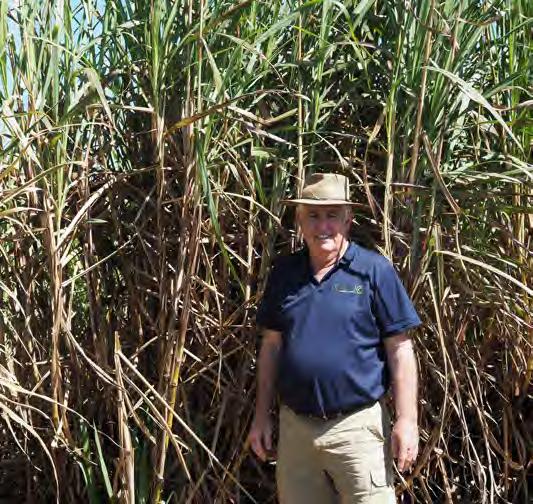
Robert has had a diverse working career. After finishing grade 10, he completed a Certificate 3 in mechanical engineering at the Babinda Sugar Mill, has worked on banana farms, built boats, sold farm machinery and driven cane harvesters.
In 2013 Robert chose a new career path, accepting a role with the Australian Banana Growers’ Council as a Reef Extension Officer. In this role, Robert assisted Far North Queensland banana growers to implement industry’s environmental best management practices and provided training in the use of the Better Bunch data recording app. He also assisted in the National Banana Development & Extension Program helping deliver activities such as the national banana roadshows, workshops, field days, NextGen, BAGMan and innovation field trials.
Fast forward to 2023 and Robert is keen to hit the ground running, meet new contacts and continue existing working relationships with cane (and banana) farmers in the Edmonton and Gordonvale area.
In his spare time, Robert enjoys spending time with his family and friends, and fishing (when time and weather permits). He enjoys his coffee with two generous spoons of sugar and is partial to a banana muffin or banana fritters with ice-cream.
In the coming months Robert will be doing the rounds, introducing himself in-person and calling in for a chat. He is looking forward to being the go-to farming contact for the Authority, providing up to date information about all things yellow crazy ants. Robert can be contacted on the number below. He looks forward to catching up for a chat soon.
For more information about the Wet Tropics Management Authority’s Yellow Crazy Ant Eradication Program see www.wettropics.gov.au/yellow-crazy-ants or contact Robert Mayers, Sugarcane Engagement Officer on 0436 613 383 or email Robert.Mayers@wtma.qld.gov.au
The Rural Health Immersion project aims to provide medical students with an authentic understanding of a rural community, to gain insights into rural medical practice and the generalist nature of rural and remote medicine.
It is intended as an avenue to generate interest in undertaking future rural placements.
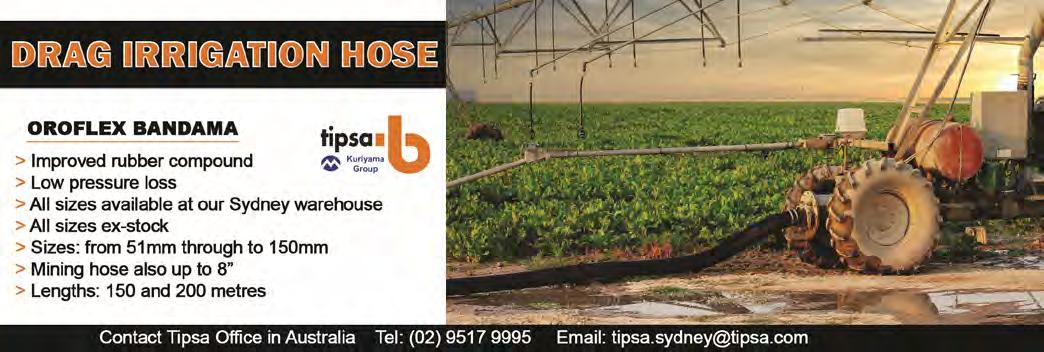
In August, 15 UQ Year 1 medical students were hosted in Childers for a weekend to provide a better sense of what rural life is like around the Wide Bay area.
The students had a tour of Isis Central mill and visited Isis grower Mark Weiss on farm to raise their awareness of the industry.
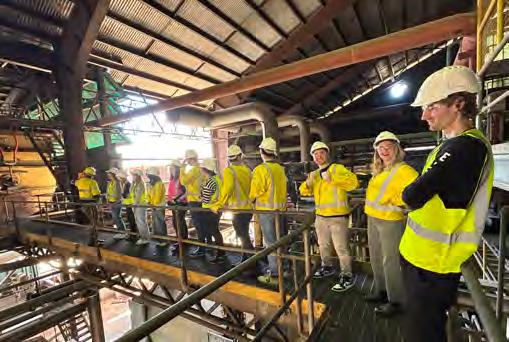
UQ student Braden Everett- Rehbein said one of the benefits of the project was the chance to get to meet the locals, as it provided an entirely different experience than just visiting the area.

“As a Bundy boy I obviously had a bit of knowledge about sugarcane, but the mill tour and seeing a cane farm was an eye-opening experience,” Braden said.
“I learnt a lot more about the industry, like how the mill ran, how cane was cut, and the many processes involved.
"It was great to learn how the industry supports the local community and how it interlinks with the health and health outcomes of the population.
“My key takeaway from the visit is just how sustainable the industry is, and how everything is used from the sugarcane is used in terms of energy, nothing gets wasted in terms of what cane be sold or used on site.”

Cvjetanovic Enterprises comprises of 680 hectares in the fertile Burdekin district and Raymond and Michelle have been managing it since Raymond’s father Peter Cvjetanovic’s passing in 2014.
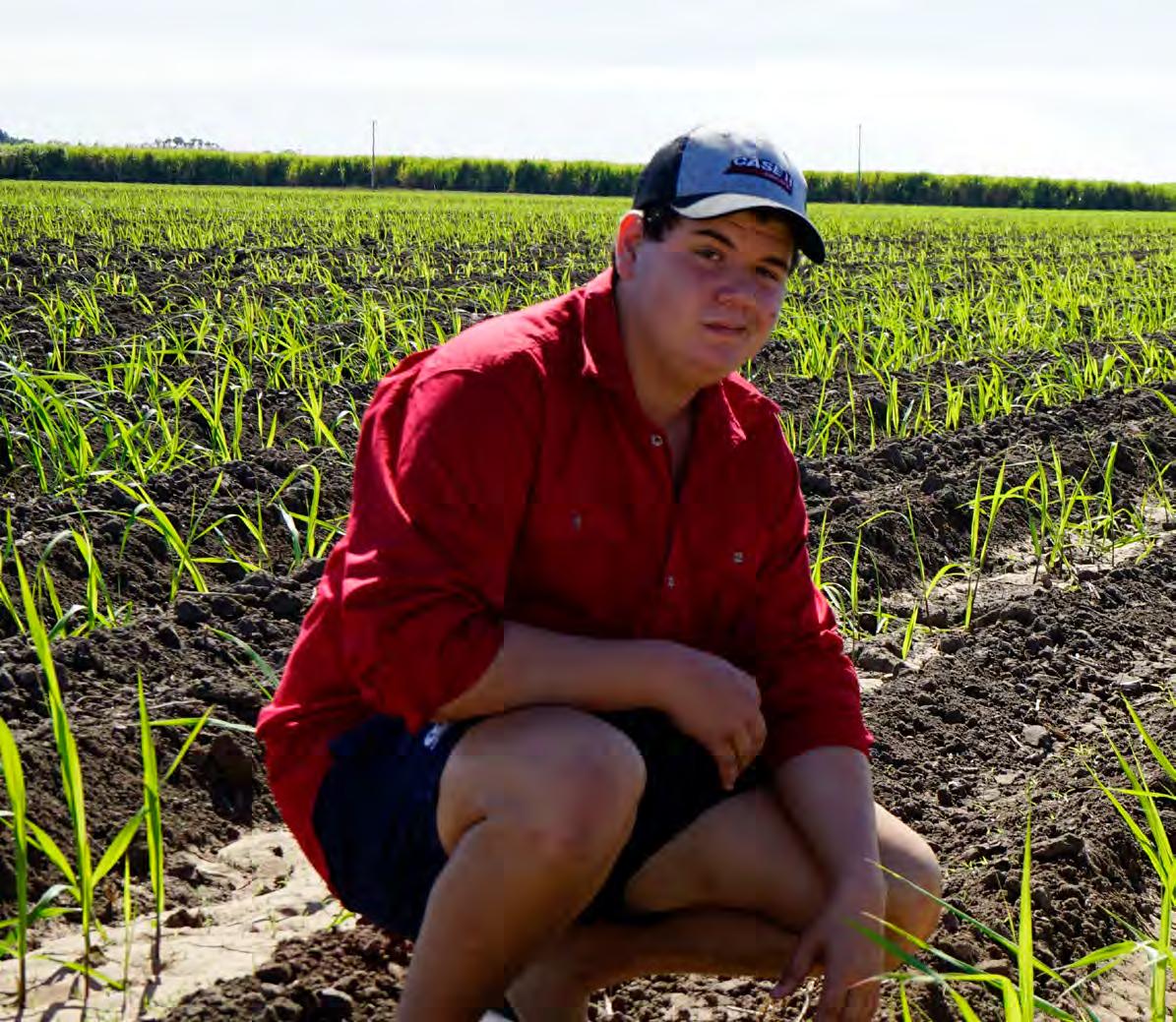
Their shared passion and desire to succeed provides a strong vision for their business practices and is an integral part of their family dynamics. After taking over the farm management they have exceeded even their own expectations.
“Normally our harvest would average just under the 70,000 tonnes so last year with the extended wet season when we hit 74,000 tonnes, we were thrilled,” Michelle said.
“Raymond and I were born into cane farming and grew up nearby to each other, we knew each other through the families.
"My family leased a farm off the Cvjetanovic family and I lived around the corner and now here we are managing the family farm together and loving every bit of it.”
Initially the Cvjetanovic family, Raymond’s grandparents Pero and Mare, came over to
For Home Hill growers, Raymond and Michelle Cvjetanovic, family is everything and they are proud their two sons will be the next generation of Cvjetanovics to work the family farms.
cut cane in Innisfail from Yugoslavia after the depression years when there was a large demand for cane cutters. In the late 1930s the family formed a partnership with another family and leased their first farm.
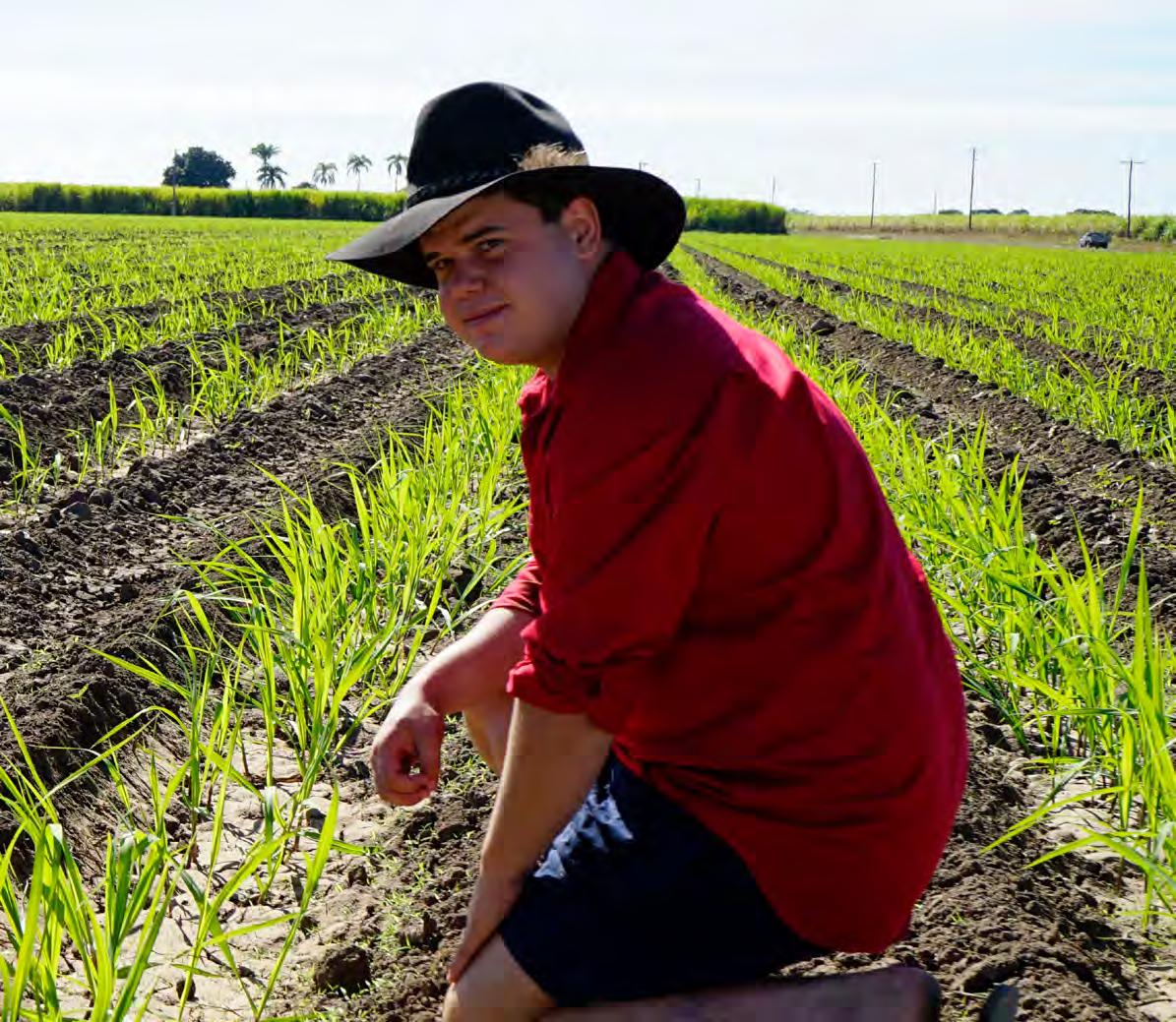
In the 1960s, the family purchased and began to farm properties in Home Hill and founded the Cvjetanovic Enterprises, purchasing more properties over the years, with two sons, Radinko and Peter managing the farms until Peter’s passing in 2014, when Raymond and Michelle took over the reins.
Raymond had been working on the farm since leaving school, while Michelle was a teacher. However once they moved into managing the business, she left teaching to take on management roles and care for Raymond’s uncle Radinko, who at 83 is retired but his knowledge and experience is still valued by the family.
Michelle’s teaching background brought with it a range of valuable skills that she has successfully transferred to assist with efficiency and productivity. She ensures that all training and inductions for contractors are in place including
A shared passion and desire to succeed is an integral part of the Cvjetanovic's family dynamicsDominik and Nickolas are keen to stay in the industry and enjoy the hands-on learning opportunities by working in the family business
workplace, health and safety, and has worked through the process to gain Smartcane BMP accreditation, which they achieved in June.
“Raymond is the quiet achiever,” Michelle said.
“He is always looking at innovation and more effective ways to do things, by upgrading our farm equipment and using the latest technology to get over the ground quicker.”

Over the years Raymond has installed new irrigation infrastructure, reducing the reliance on labour, but it’s an expensive operation.
They have been completing one project per year to assist with affordability, fixing up the pipeline infrastructure, replacing some of the older pumps with more efficient alternatives to assist with water flow and electricity costs.
As part of this maintenance schedule to assist with input costs, Raymond has implemented the use of solar panels over the past four years with mixed outcomes.
“Where we use large amounts of electricity, where we're irrigating a lot and have big areas, we can see a difference with solar panels, but the areas where we irrigate less, then it isn’t as positive,” Raymond said.
“I’m not sure that solar is the whole answer for us to reduce electricity costs, I think we need better tariffs - but that’s a challenge for all farmers.”
As well as improving irrigation, the family has been working hard to improve productivity as the goal has always been to increase the production of the farms.
Michelle is proud of the way the family works together to run the business. Taking over the management of the enterprise was a big task, but she believes having a background in farming and knowledge of growing cane helps them pull together.
18-year-old Nickolas and his younger brother Dominik, 15, are active members of the family business and share their parents’ passion for growing sugarcane, saying they couldn’t imagine doing anything else.
“I like the lifestyle, being outdoors and every day is different, you don’t do the same thing each day,” Nickolas said.
“We also get to do a bit of everything on farm, so it is always interesting.”
Michelle said growing up on farm was great for both the boys, especially Nickolas, who was always outdoors as a child, even planting his own cane from a young age and now he manages the family farms near Inkerman.
“We knew he was going to be a part of the business from an early age. There was one time we woke up to find him outside in his pyjamas watching the harvester and haulouts across the road, it was then we knew for sure he would be in the industry,” Michelle said.
Working as a family is unique and Michelle says they do everything on farm as a family with a shared passion. The farm means everything to them.
“It’ll be 8 o’clock at night and it might be time to go check the water, we will jump in the vehicle and off we go as a family,” Michelle explained.
Solving problems together and looking for the positives in any situation is the family motto.
Michelle explained how they gained this wisdom from her father-in-law in 2010 when
"There is always a solution to a problem."Nickolas won the Honeycombes Tractor Pull in 2022
the global sugar market was not as optimistic as present, and that crush they hadn’t been able to harvest all the cane. Peter sat Raymond and Michelle down and said that “there is always a solution to a problem”.
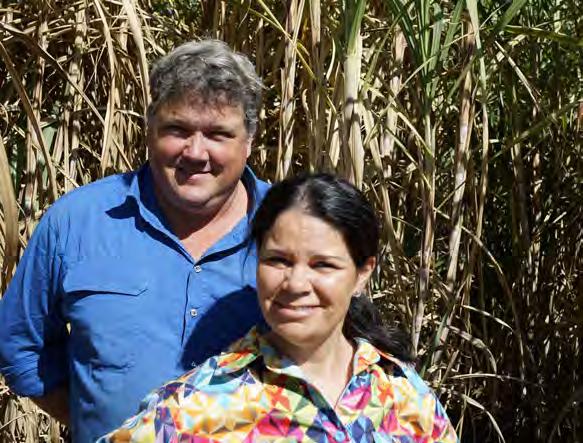
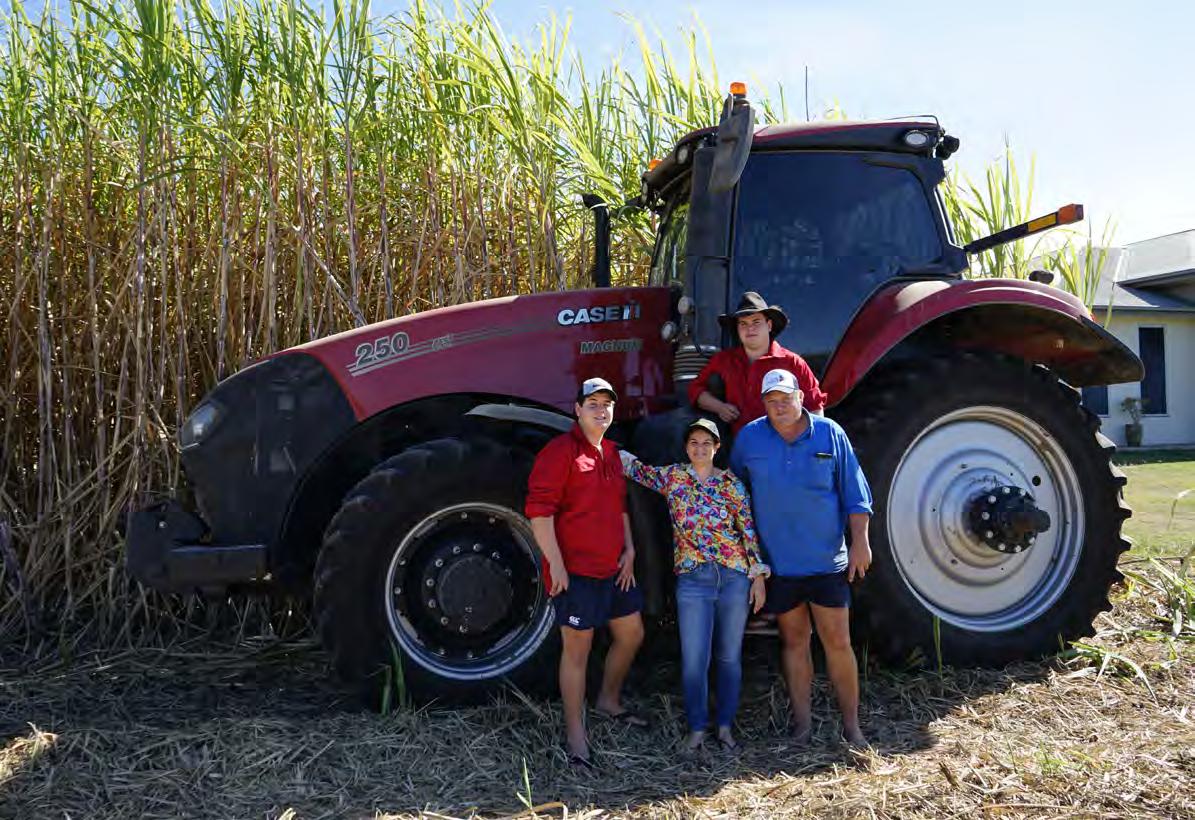
“That is the way our family tackles everything now. Just find a solution to the problem, his advice has stayed with us,” Michelle said.
“And my father-in-law was right, as in 2011 we were back cutting cane and look at how the business has grown.”
Challenges in the Burdekin district are no different to other areas of the state especially in relation to labour issues, with harvesting contractors finding it hard to engage and
retain the right workers. In 2018 there were 110 harvesting groups and now there are only 90 groups.
“One of the biggest challenges remains keeping the harvesting contractors out there in the fields,” Raymond said.
“People from the region are moving away as the costsof-living rise and looking for higher paying jobs elsewhere, and the farmer’s sons are all moving away, it’s a worry for the industry.”
Michelle and Raymond look to the future with a mix of emotions. While they foresee challenges for the industry, they remain optimistic about their family business. Nickolas and Dominik’s choices to work on the farm in the family business and stay in the
industry is not so common any more in the region but remains a source of pride for the family.
Whatever future lies ahead, the Cvjetanovic family will meet it with positivity and practicality as a family together with a shared passion.
“I’m proud as punch as I get to work with my two boys and husband – what more could you want.”
Sharing their passion is important for Raymond and Michelle Cvjetanovic The family work together around the farm no matter what the job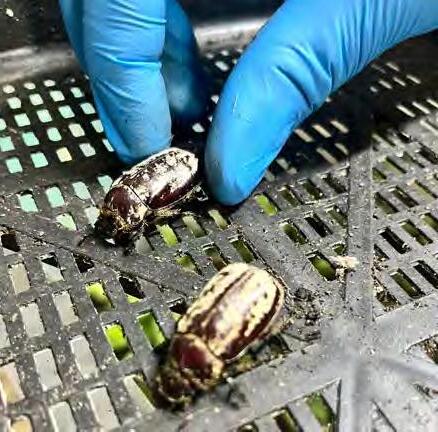
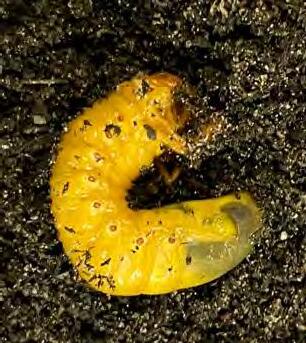 By Renee Cluff
By Renee Cluff
As the Australian government considers new regulations for the only current chemical control for canegrubs, progress is being made in finding an alternative. At the same time, growers have managed to significantly reduce runoff of the insecticide into coastal waterways.
Imidacloprid is used by many agricultural industries across Australia to control pest insects and in the sugarcane sector, it’s the only current option for dealing with destructive canegrubs. It’s been banned or restricted in many parts of the world, mainly because of its effect on bee populations, and the Australian Government has been assessing whether to follow suit However, sugarcane growers are now among those leading the way in successfully reducing the environmental impact of the insecticide, specifically its effects on aquatic life.
Since 2018, there’s been a distinct downward trend in detections of imidacloprid in the Tully, Johnstone, Mulgrave and Murray catchments of the Wet Tropics, while promising results are also coming out of the Herbert and Burdekin districts.
Terrain Natural Resource Management’s Water Quality Monitoring Leader Alicia Buckle has been running a number of projects, including local scale water quality monitoring across the Tully, Johnstone and Murray basins, and said detections of imidacloprid have consistently reduced in creeks and rivers at the sub-catchment scale.
“At some sites we’ve seen a 10-fold decrease in imidacloprid concentrations and far fewer exceedances of guideline values in 2023 compared to what we saw at the same sites in 2018,” she said. “If it’s below the guideline, it’s considered of low risk to the aquatic environment.”
The catchments take in both sugarcane and banana growing areas and Alicia said there has been a collaborative, multi-organisational effort to achieve these results.
“From what we can see so far, farmers are doing a pretty good job of managing it,” she said.
“There’s still some work to be done but I think what we’re seeing is evidence that, when used appropriately, we can greatly reduce the risk to aquatic life.
"From what we can see so far, farmers are doing a pretty good job of managing it"Canegrubs in the lab. Supplied SRA
“It’s a very similar story across both industries in that growers are increasingly being more observant and only using it when and where they need to use it.”
Dr Ryan Turner, Science Leader of the Reef Catchments Science Partnership at the University of Queensland, has been studying imidacloprid detections at end of catchment since 2009.
He says the question of why detections have dropped in certain areas is complex, involving a number of factors. However, he said how the chemical has been used in recent history does tell part of the story.
“There was no real change in detections between 2009 and 2012, but from 2013 onwards, all of a sudden we started seeing many more higher concentrations exceeding the water quality guidelines,” he said. “There was a general increasing trend across the coast.
“Around the same time, there had been a marketing campaign by one of the chemical companies that its imidacloprid product was a stress shield and subsequently you might get some extra benefits of protecting your crop from stresses such as drought or extra rain.
“Also at the same time, the disease Yellow Canopy Syndrome hit the industry and there was some anecdotal evidence that imidacloprid was helping fix that – which subsequently, was debunked.
“Everybody had started using it everywhere very quickly.
“Since then, there has been a concerted effort and an extension effort by everyone at shed meetings talking about water quality and the issue across the state, but also the mills, CANEGROWERS, resellers and the growers themselves have realised they need to use this chemical more wisely because it’s an essential part of their tool kit.
“Recent work from a University of Queensland student - Mr Heinrich Rass - is showing that certain sites are now trending down and others have plateaued and are not going up.
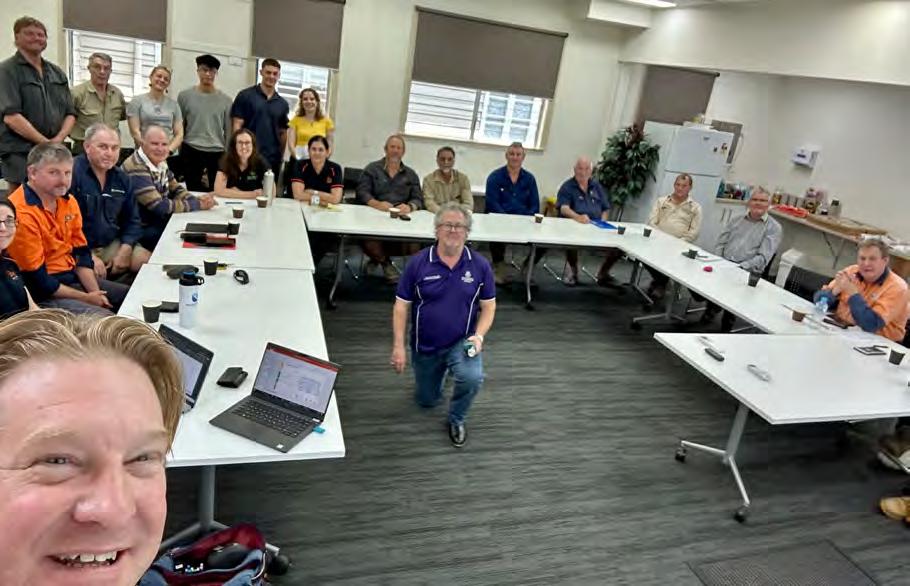
"This is a credit to the growers’ efforts.
“Some notable examples include in the Johnstone and Mulgrave where there was a plateau and then a downward trend in concentrations. The Herbert and Pioneer are slowly coming down too.
“Tully sugar growers, with their stewardship, have really been able to turn it around, with significant decreases in concentration being observed in the Tully River.
“Good farm management and the use of a chemical in the most appropriate way shows that you can be responsible and sustainable.
Greg Shannon, Cane Productivity and Development Manager at Tully Sugar Limited (TSL), has been among those at the forefront of
leading practice change at field level. He says the story of why canegrub control methods have become more strategic and targeted includes other elements.
“Sometime around 2016 we discovered almost by accident that many growers were using imidacloprid just in case, when they actually had no grubs but did in fact have Pachymetra root rot disease,” he said. “We knew that Pachymetra was a big issue in parts of our district following a TSL-led Pachymetra survey in 2013.
“By a process of grub digging and further Pachymetra sampling including a follow-up district Pachymetra survey in 2018, we were able to promote, along with new Pachymetra-resistant varieties through the Tully Variety Management Group, the proper stewardship of imidacloprid.
“Tully Sugar also took on the DES water sampling contract for the local area in 2015 because we wanted to know exactly what was going on in terms of water quality in our region. If we can measure it, we can manage it.
“The whole process seems to have worked as we started to notice in 2017-18 that the imidacloprid levels in Tully started to drop.
“This wouldn’t be the whole story, but I think it must have contributed.
“We are now working in the Murray catchment to keep imidacloprid use to where it is really required.”
The data presents a good news story which could influence the current review into the use of the ingredient.
Imidacloprid is a neonicotinoid insecticide and the Australian Pesticides and Veterinary Medicines Authority (APVMA) is assessing whether neonicotinoid products continue to meet the safety and labelling criteria in accordance with the Agvet Code.
Currently, imidacloprid is the only ingredient that can effectively control canegrubs, and there are 20 different species affecting sugarcane in Australia.
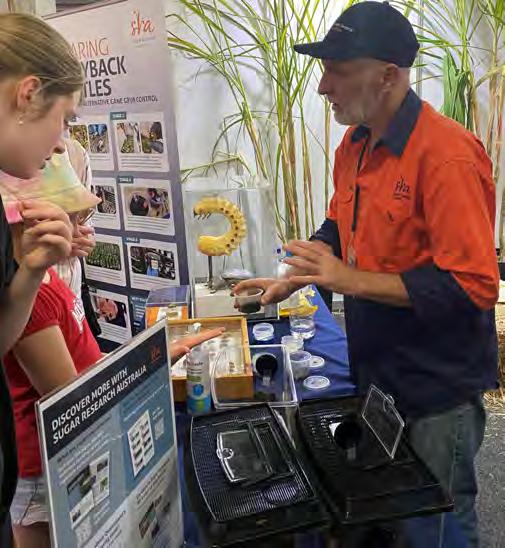
If the pests are not or cannot be managed appropriately, more than half of Australia’s cane growing area is potentially at risk, threatening the sustainability of the industry.
That’s why work is now being undertaken to reduce the industry’s dependence on imidacloprid as the single tool for canegrub control.
The project is funded by Sugar Research Australia and the Queensland Department of Agriculture and Fisheries and is being conducted in collaboration with a range of agrochemical companies.
Leading the research is SRA Entomologist Dr Kevin Powell, who’s expecting to begin experimental field trials in 2024.
“We are at the laboratory trial stage, working with three agrochemical companies who have supplied us with 15 different non-neonicotinoid products to test and compare with imidacloprid,” he said. “As you can appreciate, that’s a lot of products for testing so the lab work needs to be done rigorously before we can say we are onto a winner with one or more of the products.”
As well as testing chemical products that aren’t neonicotinoids, biological products (biorationals) are also being scrutinised. “We are trying both ways because if we totally rely on chemicals we don’t want to be at the stage in a few years where it also has to be reviewed,” he said.
“In terms of the biorationals, I can’t say too much at this stage, but it could be a microbe or a toxin from a microbe that are being tested. The potential benefit there is that if they work, then there’s less potential environmental impact. Also, if we could have a couple of active ingredients which have different modes of action it will improve resistance management.
“We’ve got three or four options that look good in the laboratory, but I want to ensure we get the whole suite of what looks promising before going to field trials.”
The project has involved breeding and rearing canegrubs in the SRA lab at Meringa, south of Cairns.
“We want to test healthy grubs,” Kevin said. “You could potentially dig up grubs and test products on them but are the grubs in the field healthy or have they been affected by other things in the soil? If you can kill a healthy grub, you have more confidence the product is effective.”
As well as testing products that cause mortality, he’s also interested in ingredients that can impact the rate of development and hence the overall lifecycle of the insects.
“If a product doesn’t kill the insect, does it impact the larval or pupal life stage and stop it developing to the next stage? If it interferes with the pupae stage, it could potentially suppress populations in the next generation,” Kevin said.
“If you look at just mortality – yes, some things are going to be very effective very quickly but that doesn’t mean they’re going to kill the whole population and you could get resistance build up.
“We will also look at runoff properties of the new chemicals to determine at what levels they could be found in waterways and what potential impact could they have on aquatic organisms. I know industry is wanting a result soon but please be patient, we have to be rigorous in our research approach to make sure we have the right product or products considered for potential registration.”
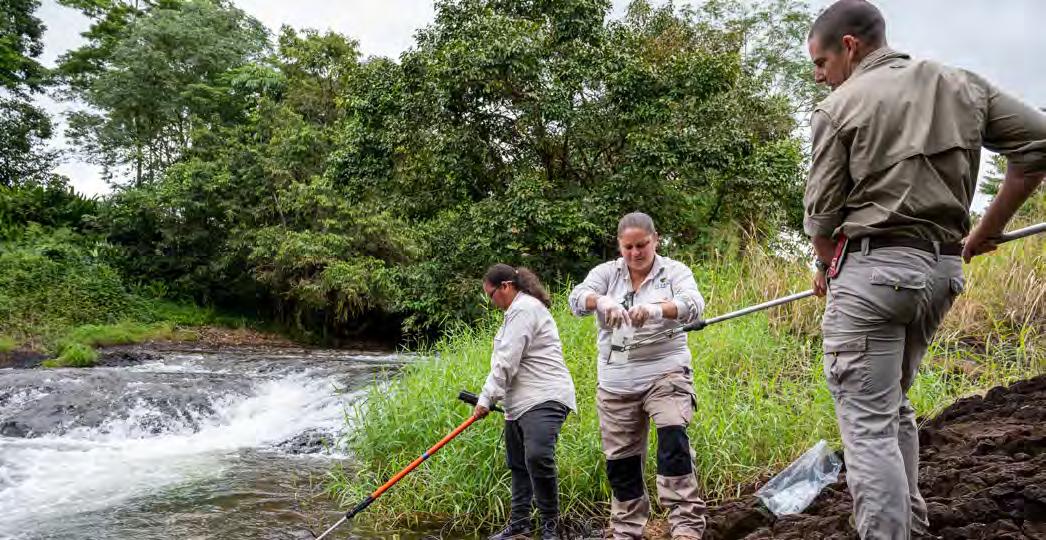
In the meantime, the advice is to continue using imidacloprid according to guidelines.
“Last season there were pretty high levels of canegrubs in some areas and I got lots of reports of high damage, so you have to be cautious with your imidacloprid use and always follow the label recommendations,” Kevin said.
“We’ve got the Greyback Canegrub Management manual which highlights how you can go about sampling and assessing risks the on your blocks and how and when to apply products correctly. It’s always important for growers to do risk assessments when they can because the danger is if you just rely on reducing imidacloprid use and not accounting for what could happen in high damage blocks, you could see increased damage - but it depends on the individual block situation.”
The APVMA’s review is currently at assessment level. Once that’s complete, a decision will be made. Feedback will then be sought through a three-month public consultation phase before any final regulatory actions are taken.
A timeline for the process is unclear, with the review already subject to significant delays.
The weather continued to influence the crushing for the Mossman Mill coastal growers during July and into August with almost three times the average rainfall in July.
The rain continued early in August and there was no cane processed for week 6 on the coast due to the wet conditions. On start up Monday 14 August, the weather had cleared, and conditions were favourable not just for harvesting but for planting, which has also experienced delays due to the wet conditions.
In week 7 of the coastal crush Mossman mill achieved the budgeted weekly tonnes of cane for the first time crushing 25,296 in a week. To the time of writing Mossman mill had processed 90,698 tonnes of cane for a mill average of 11.70CCS. Mossman Tableland growers who had been toll-crushing for 13 weeks, had 61,417 tonnes of cane processed by MSF for an average of 13.08CCS. Both coastal and tableland growers are experiencing suppressed
The change in weather to clear sunny days and cool nights has been welcomed across the region.
The prolonged wet weather had brought farming and harvesting to a halt.
CCS levels due to the amount of wet weather this crushing season.
The wet conditions are a real cause for concern as it has extended the season length on the coast by at least 4 weeks; meaning a December finish again this year. The mill held a meeting with harvesting contractors on Monday 7 August to present the crushing data to date and to discuss some possible counter measures. The Bargaining Agents then met on Tuesday 8 August to go over the same data and discuss what actions may be agreed upon to pull back season length. Two of the options discussed and agreed upon were cutting Sunday afternoon by harvesting groups who are behind by more than the equity percentage and the possibility of working a full shift on Saturday so in those weeks it would be a six-day crushing week.
On 10 August, SRA held a meeting with local representatives about a possible opportunity for Reef Funding for a project in the
Mossman district. It would be similar to a project run in the Mulgrave area and focus on productivity improvement through removal and management of constraints to productivity. All stakeholders at the meeting were keen to see an application submitted along these lines for this funding.
The Manager attended a FNQ Regional Plan Workshop in Cairns on 3 August. This review is being run by the Queensland Department of State Development, Infrastructure, Local Government and Planning and was looking at updating five areas of the FNQ Regional Plan 2031. The workshop talked about hindrances and
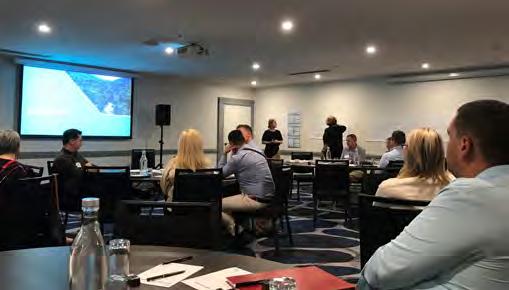
aspirations to moving forward in these areas. The areas covered Community, Housing, Economy, Transport and Infrastructure and Environment. There was good feedback given by those at the workshop and the next steps will be for the Department and their facilitators to pull together all this feedback into a summary document for the stakeholders to review.
The intention is to have a draft document available for comment by the end of 2023.
At the time of writing the southern area was still drying out and planting was once again being undertaken in the Mulgrave Area. Managing the harvest and maximising milling capacity remains the focus.
The Regions BMP accredited hectares has received boost with several growers recently receiving their accreditation including one of the region’s largest producers.
Congratulations to all those
growers involved. Despite CANEGROWERS best endeavours the implementation of QSL Direct remains unresolved.
At the time of writing, Innisfail growers are enjoying a much-needed reprieve from wet weather conditions.
The South Johnstone Factory had lost 811.9 hours to wet weather by week 9, week ending 13 August.
CANEGROWERS
representatives are working closely with MSF staff to employ strategies to make up
this lost time and ensure the timely removal of the crop.
The Board of CANEGROWERS Innisfail met with the Board of STL to further discuss the Company’s decision to insource terminal operations. While overdue, this meeting was welcomed by local representatives who reiterated the importance of communication with industry stakeholders.
The eighth Wet Tropics Healthy Waterways Report card was launched on 26 July. The news that pesticide detections were the lowest since the first report card in 2016 was welcomed by the agricultural sector and acknowledged by all stakeholders.
Growers across the Innisfail district have been urged to lock
up where possible with increasing reports of trespass and theft from sheds and properties.
CANEGROWERS Innisfail representatives continue to negotiate with Cassowary Coast Regional Council regarding the potential to co-fund an effective feral pig program for the district.
Challenges created by unfavourable weather patterns have continued to hamper the 2023 crush.
July produced 445mm with rain recorded on 22 days, and up to 16 August 2023, 136mm was recorded over the first 13 days. For the 2023 calendar year, rain has been recorded on 152 out of 228 days to the 16 August 2023, totalling 3088mm.
The following crush statistics show how the season has been impacted by wet weather, week 8 - 42,200 tonnes, week 989,200 tonnes, week 10 - 0 tonnes, week 11 - 70,000 tonnes.
On only three occasions this crushing season, the mill has been able to get beyond the 100,000 tonnes capacity per week due to the weather conditions.
By the end of the week 12, there should be around 900,000 tonnes crushed, with harvested area covering approximately 32% of the total area.
CCS is reasonable for this time of year, considering the type of season we have endured.
The current top five varieties delivered to the mill this year in order are: Q208, Q253, Q240, KQ228 and Q250.
The district yield is currently at 91 tonnes per hectare, with nine varieties exceeding the average tonnes per hectare.
Planting is still well behind, with contractors under pressure to cover the country with a narrowing window of premium opportunities.
Farmers will have to be prepared as much as possible to take advantage of conditions once they become favourable.
CANEGROWERS Tully contributed to National Science Week at local schools this month with the help of representatives from Sugar

Research Australia, Tully Sugar Ltd, Matt Kealley from CANEGROWERS, Terrain NRM and local farmers Chris Camilleri and Chris Condon. These events were proudly sponsored by Cassowary Coast Regional Council, (pictured below and see page 20 for more about this event).
During the attendances industry representatives showcased to students the 'paddock to packet' process and showed students how sugarcane growers are using technology to improve their environmental sustainability and reduce on-farm inputs.
In late July, early August we received some unwanted rainfall which slowed crushing down for a week or so.
As at 20 August the Herbert River district had crushed 1,359,829 and the CCS average season to date is 12.66. There still remains a fair bit of standover in the paddock.
CANEGROWERS Herbert River recently met with Herbert Cane Productivity Services Ltd (HCSPL) and Sugar Research Australia (SRA) to discuss how we can work together for a long term sustainable future for the Herbert River District Sugar
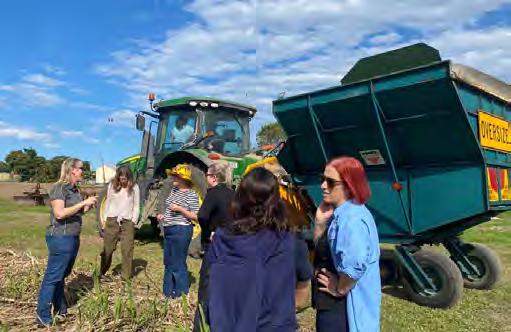
Thankfully, the month of August saw the resumption of crushing in earnest after the wet weather stops in July brought everyone’s season to a halt.
The delay has cost the district valuable crushing time, placing us roughly two weeks behind schedule but we are now making the most of the sunny days and dry weather to get the crop off. CCS was affected by the rain stops and quickly fell below budget, but now it is gradually starting to increase and is in the mid to high 14’s. The factories have been performing satisfactorily upon restart, albeit with some issues around high liquor and reliability and continuity of bins supply at some sites remains challenging. It's great to see the district become a hive of activity once again, as we need to get the crops converted into crystal and sitting in the sheds at the Townsville Port to capture the high sugar prices. Wilmar have stated that they
industry. This was a very productive meeting, and we are planning to continue our collective efforts in achieving a prosperous future for the Herbert River Sugar industry.
In early August, Herbert River District was selected by the Department of Climate Change, Energy, Environment and Water (DCCEEW) to visit and to talk to three growers involved in the Lower Herbert Water Quality Program (LHWQP). The department requested the program to showcase one grower from Agro Group’s mill mud project, HCPSL’s ProjectCane and one from
Major Grants Project. Well done to all the growers involved including the project deliverers who represented the Herbert
are revising the district estimate which they hope to have completed by the end of August, and some harvesting groups in Invicta are off 10% in their adjusted positions to date.
Once the estimate is revised, Wilmar will then do a full review of their operations plan including projected finish dates. We doubt that the original estimate of 8.4 million tonnes will hold as we will soon be running out of plant cane to harvest and will be into ratoons and there is some doubt as to how these ratoons will cut.
At the time of writing, the next Harvest Management Group meeting was scheduled for 31 August and we may receive an update then on the revised estimate and how it is looking.
The gap between factory finish dates is of concern, although this may change when the crop estimate is revised and CBL has requested a meeting with Wilmar to discuss cane transfer, as it is our policy to see Wilmar
optimise district crushing capacity via cane transfer to try and achieve a similar (or thereabouts) finish date across all four factories.
Burdekin Productivity Services held their AGM on 25 August where they provided an update on their business activities over the reporting period to 31 March. The Burdekin is fortunate to have such a well-managed Productivity Services Board and would like to congratulate the Board, management and staff on doing a great job on behalf of the industry. Key takeouts from the AGM are summarised as follows:
• Seed cane sales were up on last year and they acknowledged the support from all plot holders and managers. They reminded members that the regular purchase and use of approved seed cane remains the foundation of a well-managed farm. No RSD was detected at any of their
approved seed cane plots and all plots are operating back at full capacity
• In regard to RSD, what is of concern was the decline in the number of growers having their own proposed plant source tested for RSD which BPS offer to test 3 weeks prior to planting. The number of such tests from grower cane conducted in 2022 was 397 tests taken whereas 2023 year to date has only seen 171 tests requested by growers.
• Canegrub damage is increasing with a loss of 25,066t recorded for the 2022 season. Whilst this is not a lot compared to the bad old days when the district lost 400,000t to cane grubs, it is the trend in the rate of increase that is of concern and growers are encouraged to talk to BPS staff about which product and application may be best suited to your farm.
• Smartcane BMP – the Burdekin now has 78 growers accredited which accounts for 30,367 hectares and participation in the BMP program is recommended to help the industry demonstrate self-regulation.
• BPS is in a sound financial position and is financially well managed which has seen the grower share of the levy of 7c/t remain unchanged for the last 11 years.
• Q240 is clearly the dominant variety and represented 52% of all plantings in 2022. This poses challenges in terms of risk management and it is
best practice to ensure a mix of varieties across a district and farm. With Q240 becoming a dominant variety, it exposes the industry and each farmer who has more than 40% planted to Q240 to greater risk.
• Farm productivity data –BPS have reported that they have only received 63% consent from growers for Wilmar to release productivity related data to BPS. From a biosecurity and variety management perspective, it is essential that BPS get as close to 100% of the district data to provide accurate pest,
disease and productivity information back to growers and industry. Growers are strongly encouraged to log into GrowerWeb and provide their consent to release this information
CBL would like to congratulate the following members for their productivity awards for the 2022 season at the BPS AGM; Tom Lewis for Jaswell Pty Ltd –
Highest CCS at Invicta, Chris Mann – Highest CCS at Inkerman, and P & C Farming
- Highest average tonnes/ hectare at Inkerman and most importantly the coveted award of highest tonnes of sugar/ hectare of 23.75 ha in the whole Burdekin district which is a fantastic achievement for the Pagotto and Contzonis families.
Proserpine mill resumed crushing operations on 7 August following 12 days of wet weather that started towards the end of July.
Despite most of the region maintaining high moisture levels, a total of 491,485 tonnes of cane had been processed by 19 August.
This was 27% of the estimate with crush rates continuing to improve for the previous week (almost 89,000 tonnes being crushed in week 10).
Despite facing a few mechanical challenges with both the mill and loco fleet, crush rates were closer to target due to low down times.
This was welcomed by growers with the majority the crop still awaiting crush.
Even with wet conditions, CCS remained ahead of budget with the mill’s season to-date average at 13.59.
Due to high soil moisture, harvesting groups continued to target drier paddocks with sustained warmer conditions needed for wider harvesting access. These included stand-over areas which are expected to have some impact on cane quality over August and September.
The estimate for the season remains at 1.8 million tonnes
and despite good winter rainfall, the final crop is still expected to fall short of this number due to areas that were harvested late in the previous season. Sugar Services Proserpine (SSP) secured the appointment of a new Productivity Manager, Stacey Corrie. Stacey started on 21 August and is warmly welcomed by the grower community.
Previous Manager, Frank Millar, will continue with SSP in a supportive role as he looks forward to a well-deserved retirement towards the end of 2024. Frank has served Proserpine growers for 13 years, initially with BSES and

then with SSP.
CANEGROWERS Proserpine continued to assist members with various disputes and made submissions to Sunwater regarding the proposed price path.
The increase in both electricity and water costs going into the 2025-26 season will be significant.
Growers are advised to review their irrigation system efficiencies and tariff selections where irrigation costs continue to inflate.
Cooler temperatures and less rainfall across August is seeing some positive movement for the crush, and with CCS now getting over 13 units.
Disappointingly, at mid-August, throughputs were still at around 25% of the crop processed. That said here have been continued milling performance issues, including a failure of
Otherwise Mackay Sugar is reporting attention to leaks in production line components
occurring on the fly. Poor quality standover cane delivered to Wilmar Plane Creek created a choke on the rotary juice screens, creating a stoppage.
Following heavy rain across Mackay region in late July, including falls of up to 100mm in some localities, mills ceased crushing for a week. This was owing to cane supply, and to track inspections in the Mackay milling area. There was further delay for some growers in lower lying country where paddocks stayed wet for an extended period.
Show season has concluded for the region with some strong performances from Michael Sant, Mark Sant, Doug Pedersen, and Deon and Andrea Borg in the Sarina Show, and from the Ferlazzo and Townley families in the Mackay Show. At the Pioneer Valley Show, honours went to the Barfield
Bundaberg Sugar Mills processed 47,795.68 tonnes for the week ending 13 August 2023.
This brings the season to date to 471,709.88 tonnes. The average CCS for Bundaberg Sugar Mill for week 11 was 14.45 CCS.
The season CCS average for Bundaberg Sugar Mill is at 13.56 CCS.
The highest individual CCS for the week was 17.90 units for Q240A Old Ratoon and the highest variety average CCS for the week was 15.03 units for variety Q238A.
family, with some strong entries from the Zarb, Blackburn and Bourke families.
The Mackay District Office has welcomed Michelle Martin into the District Manager role, which streamlines the former CEO and Grower Services Manager roles into a single position.
Michelle has served in Growers Services for over two years, managing that department since May 2022.
Any growers requiring assistance with any issues are encouraged to call 4944 2600 to get the ball rolling on a solution. Keep an eye on our Facebook page and weekly CEO Updates for emerging training and industry opportunities.
The weather has continued to stay dry across the district with some growers indicating their estimates are starting to drop due to the drier weather.
The dry weather continues and looks like it will for a while yet with some reports a possible change in the weather pattern won’t come about until October.
With the dry weather the harvest has progressed quite well with only minimal time lost. CCS has continued to rise with some extraordinary high tests for this time of the year.
We currently have the base CCS set at 13.8 with the YTD relative average CCS sitting at 13.91 for week ending 14 August 2023 and we are approximately 44% through the total season (including pre season).
With the drying of the crop comes reductions in estimates and Grower Services Officers have been adjusting these figures where required.
With the current dry conditions comes a heightened fire risk, currently there is no fire ban in place and as such growers can still light fires for standing cane and trash blankets provided they are lit after 4pm and are fully extinguished by 9am the following day. By following this request growers can delay further restrictions on allowed times to burn until later in the harvest if dry conditions persist as expected.
If you have any questions about burning cane please contact Matt Leighton on 4151 2555.
Oreco have been quite active in baling trash and seem to be on top of the demand although they are still looking for extra trash.
New machines allow a lesser take therefore you may be able to supply 50% of your trash and retain the remainder for your own use.
If you do not have a current Cane Trash Supply Contract or you have excess trash, please contact the office on 4151 2555.
Isis Mill is performing well and is consistently crushing around the 60,000t mark each week.
The season's highest individual CCS was recorded in week 7 by a Wallaville grower at 17.36 for some Q240 autumn plant cane.
Most growers have started to plant with Isis Productivity due to commence clean seed distribution in the first week of September.
We have continued to work with the Isis Mill and Maryborough
CANEGROWERS on improving the efficiency of the Maryborough haulage system. We recently met with QSL and provided them with feedback on the roll-out of QSL Direct. We have been working closely
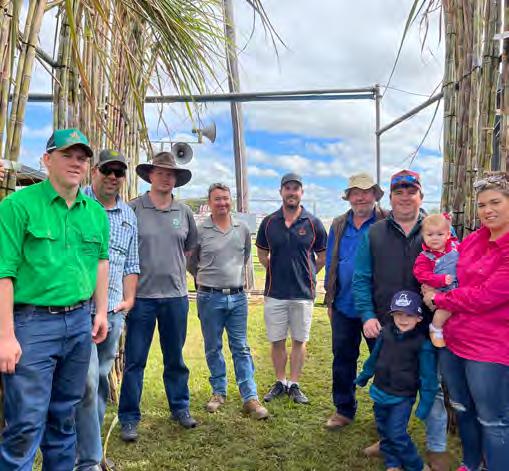
with growers assisting them with electricity tariff comparisons in readiness for the predicted drier weather to come.
We recently accompanied a group of first-year medical students from UQ to local grower Mark Weiss’s farm. Mark talked to the group through growing sugar cane, gave them a chance to watch harvesting up close and cut up a few sticks for them to taste.
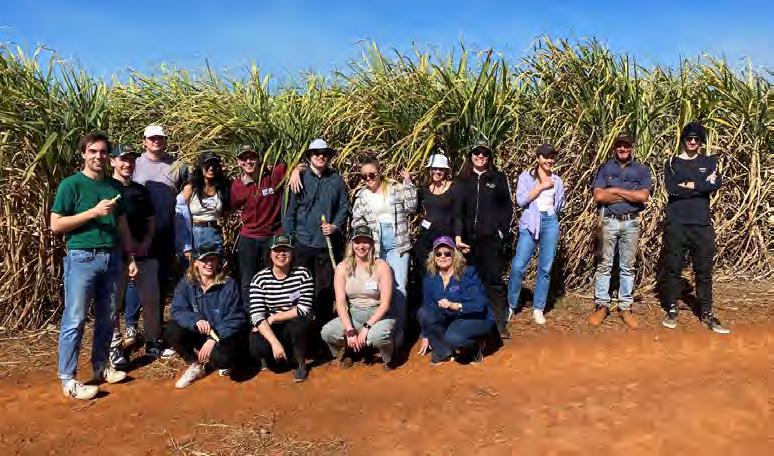
The students were visiting Childers as part of a four-day immersion tour to experience the charms of rural living.
Week 9 has now commenced and we will be almost 150,000 ton delivered.
In 2022 we had slightly behind this and conditions continued to become very wet. The weather is certainly not looking like that this year.
Isis Central Sugar Mill board of Directors conducted a meeting at the hall to cover progress for the season, plans for future and a chance to meet in person with growers.
This was appreciated and well attended considering we are in
The Mill/Cogen have been in the final stages of their maintenance program and the crush commenced on Wednesday 23 August.
Many tonnes of cane have been lost due to dead sticks in the two-year old cane. Rocky Point is currently experiencing a drought, providing for great harvesting conditions. However, as growers are preparing to plant, it would be
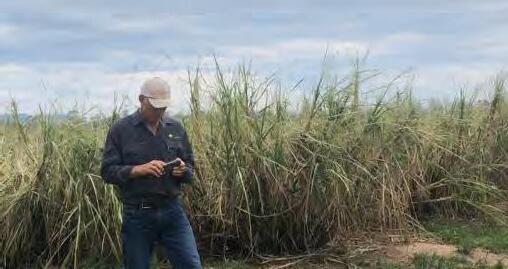
the middle of harvest. Future improvements to the transloader are intended, and keeping costs down across the operations is the focus at present.
Trailer fleet is largely operational although several trailers were damaged a couple of weeks ago during loading. Pressure on transport also occurring through loss of a drivers.
Planting activity is starting through the district with a number of new varieties being taken up by growers.
McDermott has been very busy with the last RSD testing and distribution of seed
before commencing his holidays in early September, pictured above in 2021, when
he was inspecting hail damaged crop. We wish him well following the Wallabies around for the Rugby World Cup in France.
helpful to have 20 to 50mm rain to freshen up the fallow.
The Board of CANEGROWERS Rocky Point are looking at projects for our SRA productivity plan, with the important issue at present, RSD education and control.
The Fire Ant Suppression Taskforce (“FAST”) delivered more fire ant bait to Rocky Point on 18 August, for growers participating in a Collaborative
Agreement to apply the next round of bait on their properties.
We have been extremely frustrated at the speed with which the fire ants are proliferating in the district. The latest Fire Ant Response Plan 2023–27 is even more disappointing because the eradication phase of the Plan will not reach Rocky Point for an estimated 6-7 years.
Since fire ants were found near the NSW border, there has been increased media activity on fire ants in the Northern Rivers news. Some of our directors have given media interviews about the impacts the ants have had on the Rocky Point sugar and associated industries and how, in our opinion, Biosecurity Qld have failed with the suppression program in this area, as the ants just continue to spread.
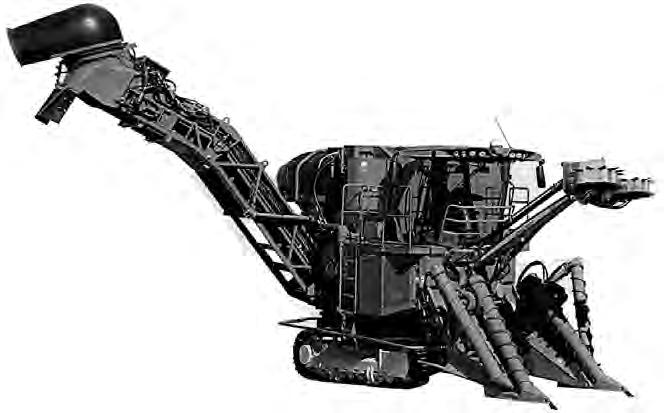
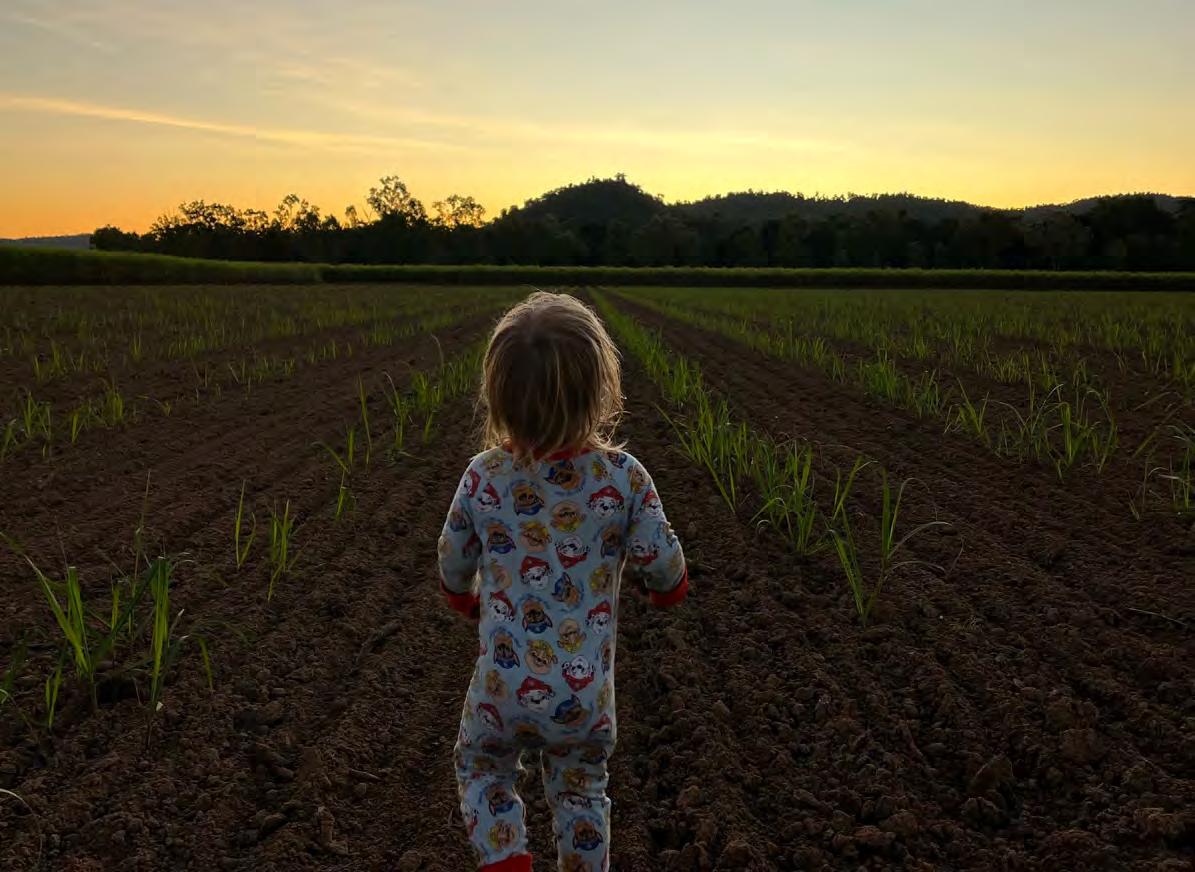
In what was a challenging and typically wet Far North Queensland harvest in 2021, the Condon family took advantage of the innovative design of the new John Deere CH960 to maximise harvesting efficiencies.
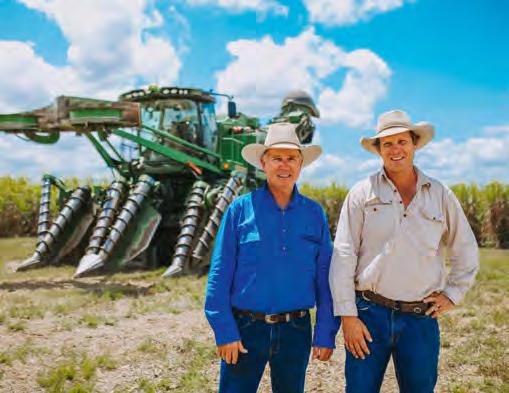
Owned and operated by father and son combination Neville and Chris, and their wives Heather and Tammy, the Condons’ business is one of Tully Sugar Mill’s largest suppliers and relies on efficient and reliable machinery to support high intensity harvest seasons. The family welcomed the CH960 machine, one of the first John Deere two-row cane harvesters to be brought onto Australian soil, as part of a trial of the new machine in 2021 – and have put it to work again this year to cut 1600 ha of its 2300 ha cane crop.
The John Deere CH9 Series Cane Harvesters operate at similar speeds as single-row units in most conditions but have the ability to cut two rows of cane simultaneously, dramatically increasing productivity. The flow-on effects of this enhanced capability means cane bins are loaded in half the time, to slash the overall cycle time of the haul-out fleet.
The late Neville Toft, a globally recognised and widely respected sugarcane harvester innovator and former Product Specialist for John Deere’s Global Sugarcane Business, initially pitched the idea of a trial of the CH960 on the Condon family’s farm several years ago.

“He said it would just be perfect for our business,” Neville Condon said.
“If you drive around our farm and look at how many rows of cane we have, knowing you can cut the number of passes in half with this harvester is incredible.
“In terms of productivity, a two-row machine is definitely a game changer.”
C hris said the initial trial of the CH960 during the 2021 harvest, where it was cutting alongside the business’s existing CH570, coincided with extremely wet and tough conditions.
“However, for a trial, it’s good to see the performance of a machine when it’s not working under perfect conditions. The weather is one of our business’s biggest challenges – and it’s something we cannot actually overcome, so we need to learn how to increase efficiency under any conditions.
“On our best harvest days, the CH960 doubled productivity, and in wet conditions we still gained a 30% to 50% improvement in terms of how much cane we could cut within a regular shift.”
Looking through machine data across the Condons’ fleet of tractors, Chris also noted the fuel burn for haul-outs was reduced.
“Saving fuel across our haul-outs was totally unexpected for us,” he said.
“Normally, our haul-out operators cannot finish a shift without filling up about two thirds to three quarters of the way through, but they were able to complete the full shift without refueling with the CH960.
Chris said the fuel efficiency was achieved as the haul-outs were spending less time under the elevator of the harvester.
“That’s where they seem to have their biggest fuel burn, because when they are in the cane paddock it’s softer dirt, so harder work for the machine. The tractors also spent less time idling, and the paddocks were finished earlier.”
In terms of operation, Chris said their experienced harvester operators, who are part of the business’s eight full-time and five seasonal worker staff base, were
impressed with the ease of use from within the CH960’s cab.
“It’s a very impressive workstation, and they said they had no trouble driving it,” Chris said. Visually, from just watching it work, we also noticed the cleanliness of the harvester was very impressive. There is more space for the cane trash to fall off the equipment, so this will save us some time on labour at the end of the day with cleaning.”
Neville was also struck by the harvester’s ability to minimise soil compaction and disruption across the farm’s sandy loam to sandy clay soils during the wet and boggy conditions.
“It moves across the ground very smoothly, and it turned on our headlands very well, it must be so well balanced as it didn’t disturb the soil at all,” Neville said. Thinking further ahead, Chris also believes the CH960 will require less on-going maintenance.
“The wear and tear on the harvester should be reduced, just in terms of track maintenance as it’s travelling half as much. So, changes to the walking gear, which can be an expensive component, should be reduced as it’s doing less hours,” he said.
Although the Condon’s cane business is well-established, the farming family historically focused on breeding and turning off
Brahmans in the southeast Gulf region’s Greenvale and Mount Surprise districts. In 2002 they secured a portion of the iconic King Ranch cattle station near Tully from the South Johnstone Mill as a drought mitigation strategy given the town is the wettest in Australia and experiences annual falls of 4.25 m of rain. At the time, they had intentions to develop the land for optimal livestock production. This plan soon changed when they identified the vast opportunities presented by the sugar sector and diversifying their operations.
“Every decision we make like that is a big decision and we put a lot of thought into it,” Neville said.
“We looked at the dollar return and decided to get into cane in a bigger way.”
Since then, the cane business has evolved and expanded again in 2021 with the purchase of a 526 ha close-neighbouring farm, bringing the Condon’s total landmass in the Tully region to 4496 ha.
“We are now in the position, at harvest time, where we might have to contract some of our harvest out, or buy another harvester for our business,” Neville said.
“But, with the CH960 we know we could buy just this one machine and it would be able to effectively, and efficiently, harvest our whole farm.”
 ASHBURNER
ASHBURNER
The cane harvesting sector is a critical part of the sugar value chain and it is important to look at this sector and consider the reality of the risk it may pose to the sugarcane business. The risk may be different for each individual grower, harvester group and mill area.
It is clear however that the responsibility to secure a harvester sits with the individual grower. The mills have a strong profit motive to assist growers find a harvester and often do so but it is not out of the goodness of their hearts.
Each grower should look at their own situation and assess their risk. This is just good business. Some growers buy their own harvesters and may do some contracting (particularly larger growers). This gives them peace of mind and they are in control even if the harvester is slightly underutilised and the cost a bit more.
Other growers form a separate harvesting contract business and ensure their cane is harvested within this. Some growers are part of a cooperative or syndicated harvesting group and there are successful examples of these.
Most growers however use a contractor. Even if they don’t realise it these growers are competing in the marketplace. In simple economic terms if there is an oversupply of harvesters then it will be easier to find a contractor and to bargain a price as the contractors will be looking for business. However if there is an undersupply of harvesters then the grower will be in a
weaker bargaining position and may have to pay more to attract contractors.
The onus is on the grower to be appealing to the contractor. Are we in an under or over supply position.
The growers with well laid out farms, longer rows, sufficient headland, good roads and tonnage in front of the harvester will have an advantage because it costs the contractor less to harvest the cane. Don’t forget relationships are also important in business. This is not just about being a nice person it is about trust and reliability and having a good understanding of the contractor’s business and profit drivers and working together.
There is no shortage of information about harvest best practice and the true cost of harvesting with tools like SRA’s Harvest Mate.
Having said that there is still a concern that overall the harvesting sector is under some pressure from factors outside their control e.g. a lack of harvester and haul out drivers, pressure to fill bins and escalating cost of machinery with insufficient depreciation put aside.
The graph below shows the big picture of the average tonnes and ha’s per harvester over the last 10 years by mill region. Some mill regions are below 30,000 tonnes per harvester and this seems to indicate an oversupply (if a good utilisation is over 65,000 tonnes) and some are over 65,000 tonnes per harvester which indicates that harvesters are well utilised. There is a wide range and this is not the full story.
CANEGROWERS are interested in further analysis including the age of machines the size of farms, average row length per region and age of workforce.
The main aim is to understand the real risk, take action and ensure that the sugarcane industry remains profitable.
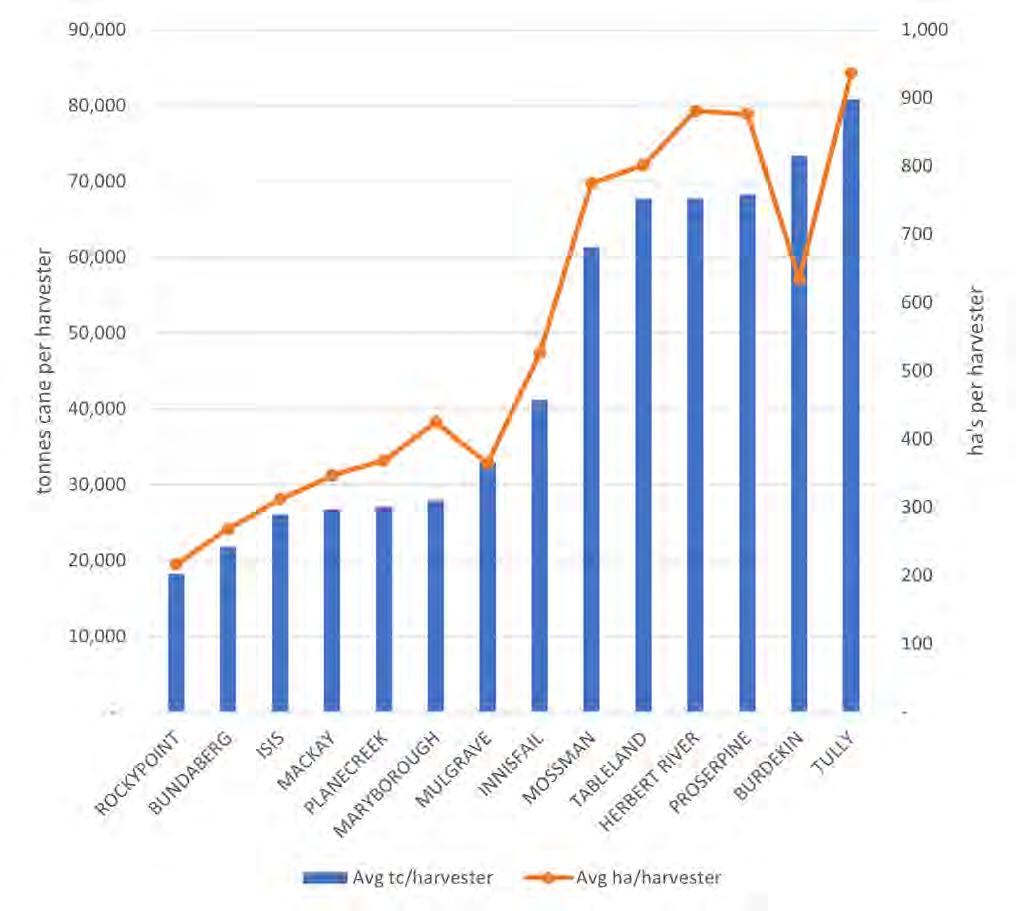
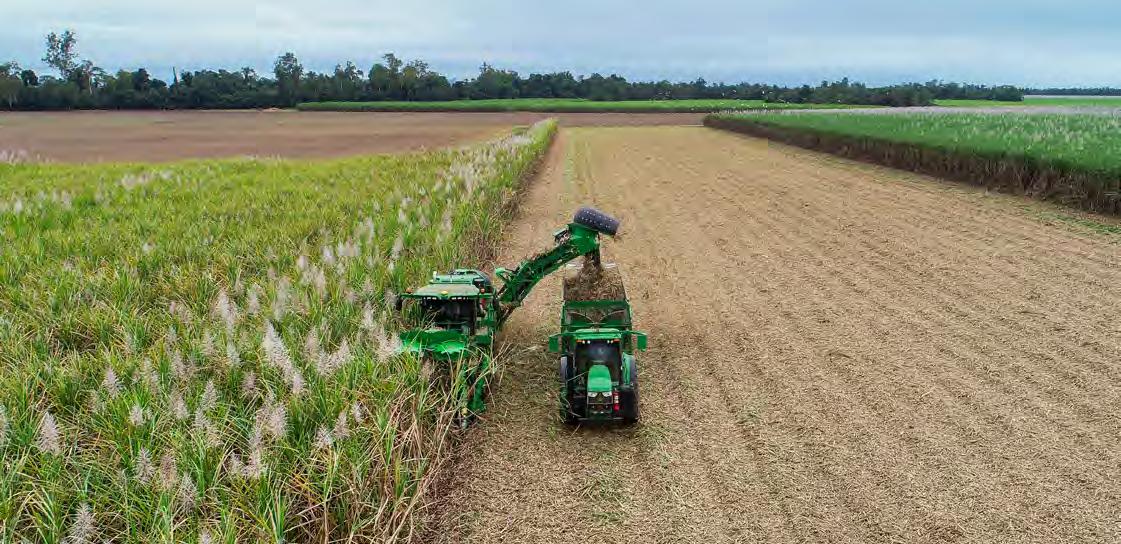 10 YEAR AVERAGE TONNES CANE AND HA'S PER HARVESTER
10 YEAR AVERAGE TONNES CANE AND HA'S PER HARVESTER

Over the last few years, American Sugar Refining Inc (ASR) have been undertaking social verification audits for sugar sourced from Australia to ensure that the sugar is produced in a sustainable and ethical way. These audits assess the social and environmental impacts of sugar production, including the impact on workers, communities, and the environment. They also help to ensure that the sugar is not produced with child labour.
In September 2023, ASR will again be conducting social verification audits with mills and Smartcane BMP accredited growers in the Tully, Tableland, Innisfail and the Burdekin districts. This work will provide assurance to ASR that the business and farming practices used in Queensland to make sugar destined for the US are ethical and sustainable.
The need to show provenance and traceability of ingredients including sugar, remains important to food and beverage manufacturers, customers and consumers. Meeting sustainability criteria and Environmental, Social and Governance (ESG) factors is important for business credibility and investor confidence. From a global perspective, the majority of sugar buyers have developed sustainable sourcing policies for sugar.
For a few years now, CANEGROWERS has been working to get more value to growers using Smartcane BMP. One of those opportunities is showing to sugar buyers that we produce sustainable sugar. The strategy to achieve this is through Smartcane BMP and the approach has been
to align Smartcane BMP with international sustainability frameworks including the Bonsucro Production Standard, the VIVE Sustainability Program and the ProTerra sustainability Standard.
ASR who are based in Florida, buy some of their sugar from the US quota. The United States imports around 90,000 metric tons of sugar from Australia under the tariff-rate quota (TRQ) and this is an important market for Australia.
ASR needs to show to their customers that the sugar they are buying is sustainably produced and meets environmental and social indicators.
To do this one of the sustainability standards they use is the ProTerra sustainability standard which emphasises the following:
• Human rights and good labour practices such as workplace safety, equal opportunities, and particular attention to preventing child and forced labour
• Good agricultural practices, regarding soil fertility, water management and continuous efforts to reduce the use of fertilisers and pesticides
• Deforestation, Biodiversity, High Conservation Values, and focus on rigorous Non-GMO requirements
CANEGROWERS has a good working relationship with ASR through the work we have been doing on sustainability through Smartcane BMP.
Since 2017, CANEGROWERS has helped ASR to better understand the sugarcane production system used in Queensland, and in recent years facilitated requests to help coordinate the social verification audits for the ProTerra sustainability standard with sugarcane growers that are accredited in Smartcane BMP.
CANEGROWERS' work with ASR is important to ensure we understand the changing needs of customers and have continued access to the US market.
By meeting sustainability criteria through Smartcane BMP, there may well be opportunities to access a greater portion of the US quota in future years due to the effort of Smartcane BMP accredited sugarcane growers.

CANEGROWERS, along with other peak farming organisations, continues to protest the Federal Government’s plan for a tax on farmers to prop up our fragile and failing national biosecurity system. The tax is described by government as a ‘levy’, making it sound like the R&D levy that funds new ideas and innovation in farm practices. But it is simply a tax that will go straight to Treasury.
Growers will have no say on how the funds are used – this is because the government wants to reduce its own expenditure on biosecurity and shift costs onto farmers. Once such a ‘tax’ is established, future increases in its rate are inevitable.
Let’s go to first principles. The Federal Government is responsible for protecting Australia from the entry of exotic pests and diseases via movement of people or materials into the country. Resourcing of our national biosecurity system should come from the existing tax base, as all Australians benefit from biosecurity measures.
For example, keeping agricultural pests and diseases out of Australia ensures reliable food production and strong regional economies and national export earnings. Any new pest or disease will make production more risky and costly, leading to increased food prices and negative impacts on both regions and the national trade balance.
There is a case for additional funding for biosecurity via charges on import businesses. These derive financial benefit from bringing goods and materials into Australia which, at the same time, presents a clear risk of introducing new pests or diseases.
But there is no case for farmers to make additional payments for a system that serves the national good. They pay their taxes just like other citizens and businesses. They also pay for managing biosecurity risks specific to their industry, through their R&D levies. For sugarcane, levies to SRA ensure we are ready for incursions by high-risk pests such as moth borers from PNG. This includes offshore evaluation of the pest’s biology and control methods. CANEGROWERS is also a paid-up member of Plant Health Australia, to ensure there is a nationally funded and coordinated response to any new sugarcane pest or disease.
Keeping pests and diseases out of Australia is a massive and complex task. One that must be adequately planned, resourced, and implemented if risks are to be minimised. But our governments have been failing in this for some time, and this grab for funds from farmers is not only unprincipled, but also draws attention away from the real issues and risks.
A review of Australia’s biosecurity system in 2017 clearly identified major inadequacies and associated risks, as well as the changes required to make the system fit for purpose. But there is no evidence of these changes being implemented, unless producing another glossy document in 2021 (“A strategic roadmap for protecting Australia’s environment, economy and way of life”) counts for anything.
The planned new tax on farmers will, at best, just prop up a system that is already broken and in need of serious attention. It should be dropped. And attention needs to be on getting a strong national system for biosecurity.
Another review is not needed – the flaws have already been well documented, and we can’t afford the consequences of more inaction and distraction.

CHRIS COOPER
I have recently received an increasing number of complaints about trespassers on cane farms. It is timely to explain the law of trespass, rights of landholders and practical options for dealing with trespassers.
Entering onto land in possession of another without lawful justification is regarded as trespass. It may be both a civil wrong and a criminal offence depending on the circumstances.
Being a civil wrong, growers may take their own civil action and sue the trespasser in the civil courts. Growers can seek a court order that requires a person to stop trespassing and to never trespass again (this type of order is called an injunction). The Court can also order that the person trespassing pay compensation if damage has been caused.
Trespass is also a crime as it is an offence under the Summary Offences Act to enter or remain on agricultural land without lawful excuse. On the spot tickets for over $300 can be issued. Formal prosecution can also be initiated by police with fines of over $3,000 and imprisonment for up to six months can be imposed. Leaving open a gate on enclosed agricultural land can see fines of over $1,500.
It is also an offence under the Nature Conservation Act to enter on any landholder’s land without their consent for the purpose of taking any wildlife. Fines can be over $25,000. It is up to the police, following a formal complaint, to take the necessary criminal prosecution action. Police will take a number of factors into consideration in determining whether to prosecute.
These include
1. Identifying an offence has been committed
2. Sufficiency of evidence
3. Public interest
PRACTICAL OPTIONS:
In some cases the legal approach may not be appropriate. Civil action can be expensive, time consuming, stressful and uncertain in outcome. Police may also be reluctant to investigate.
However, alternative action might be considered. Options include, where possible, direct discussions with the trespasser (and their parents, if relevant). Maybe neighbourhood watch or farm watch or similar Facebook groups could be activated. Community awareness programs which could be undertaken in schools and throughout the community generally might assist especially if supported by some local media coverage.
A local group comprising representatives of various interested bodies including growers, police, local council, community leaders and educators might be formed which could develop and implement local programs intended to inform and reduce the frequency of trespass.
You can eject a trespasser from your property. Under the Queensland Criminal Code it is lawful for a person in possession of land to use such force as is reasonably necessary in order to prevent any person from wrongfully entering upon such land or in order to remove such person from the land provided that he does not do bodily harm to such person.
It should also be remembered that it is an offence under the Criminal Code to set a trap intended to kill or inflict grievous bodily harm on a trespasser.
Self-help options may be a good idea. If the situation looks as if it might get out of hand though, the police should always be contacted.
Try to make a record of the trespasser’s details, including name, vehicle description, date and time of trespass, with photos/video if possible.
Signs such as Private Property or No Trespassing can assist in making it difficult for any trespasser to argue they did not realise they were on private property. Police often recommend the use of such signs at entry points when the farm is not enclosed or fenced.
Responsibility or liability for loss, damage or injury caused by or to trespassers is a complex area. Although not common and difficult to succeed an injured trespasser may potentially have a claim against the property owner. The particular facts and circumstances will always be relevant.
As a general rule, an owner or occupier of land such as a farm, owes a duty to take reasonable care to avoid foreseeable risks to persons on that land. Under Queensland legislation (Civil Liability Act) a person does not breach a duty to take precautions against risk of harm unless:
• the risk is foreseeable
• the risk was not insignificant
• a reasonable person in the owner’s position would have taken some precaution
In deciding whether a reasonable person would have taken precautions, the court must consider:
• the probability of the harm occurring
• the likely seriousness of harm
• the burden of taking precautions to avoid risk of harm
• the social utility of the activity that creates the risk of harm
Whether a grower will be liable for an injury suffered by a person trespassing on the grower's land will always depend on the circumstances of each case. Just because a person is a trespasser does not mean that they could never recover damages if they are injured whilst trespassing.
The issues of liability will be determined by the law of negligence and the High Court has stated the following principles:
All that is necessary is to determine whether, in all the relevant circumstances including the fact of the defendant’s occupation of the premises and the manner of the plaintiff’s entry upon them, the defendant owed a duty of care under the ordinary principles of negligence to the plaintiff. A prerequisite of any such duty is that there be the necessary degree of proximity of relationship. The touchstone of its
existence is that there be reasonable foreseeability of a real risk of injury to the visitor… The measure of the discharge of the duty is what a reasonable man would in the circumstance, do by way of response to the foreseeable risk.
Another landmark Court case involving injury to a trespasser, expressed the principles as follows:
The long and the short of it is that you have to take into account all the circumstances of the case and see then whether the occupier ought to have done more that he did. You must take into account the gravity and likelihood of the probably injury…the character of the intrusion…the nature of the place where the trespass occurs… [and] the knowledge which the defendant has, or ought to have, of the likelihood of trespassers being present… Each of these cases… depends eventually of the special circumstances.
The best approach is of course that at all times you act reasonably. What will be reasonable will depend on each grower's own circumstances.
The practical options mentioned previously should be considered to reduce the prevalence of trespassing and thus reduce the associated risks.
A common option to combat trespass and reduce liability is the placing of warning signs and signs designed to limit a property owner’s liability eg. 'Enter at Your Own Risk' or 'Private Property – Keep Out'. Whilst such signs may be a good idea they do not guarantee a complete defence to an action brought against the landholder by a person who is injured.
The basis of the defence is that a person is entitled to waive ones’ legal rights. In practical terms, the maker of a sign might say “you were warned – so don’t come after me if you get injured”. That is, the person can be said to be assuming and accepting any risk by entering the property. If a person enters the property after perusing an appropriate sign, then it can be argued that that person entered the property under the condition that the person’s rights were waived, and acknowledging that the property owner did not owe that person any duty of care.
An important element in the establishment of this defence based on a warning sign is to show that the person entering the property consented to waiving the person’s legal rights.
Whilst the consent maybe expressed or implied it must be real and freely given and the consent will only relate to that portion of the risk to which the consent is to relate.
The Courts can be reluctant to uphold this defence unless the evidence clearly establishes the case. To rely on the defence, it must be established that the person entering the property was aware of the warning notice. For example, if a notice is erected on the front gate and someone enters the property via another entrance then unless they were actually aware of the entrance of the sign and its contents (perhaps by previous visits) then the person will not have “voluntarily” assumed any risk.
Moreover, it has been stated by the Courts that a warning would only give complete protection to an occupier if the danger was present to the mind of the plaintiff and fully appreciated by him when entering the property. Therefore, a sign such as “Enter at own risk” even though read by the plaintiff may not be sufficient to raise the defence if the plaintiff did not realise and appreciate the nature of the risk involved. If, however, the plaintiff had previously frequented the property and was aware of the possible risks involved then the defence would have a greater chance of succeeding.
In summary a sign such as 'Private Property' or 'Enter at own risk' probably is not sufficiently wide enough to offer the landholder complete protection for all situations but depending on the particular circumstances may help in a practical and legal sense.
There are no easy answers to this issue of trespass and liability for injury. Ultimately every grower should ensure that they hold adequate liability insurance to cover the risk of injury to persons on their land.
1. Trespass is unlawful activity. It can be both a crime and a civil wrong
2. Immediate Steps
If you see someone trespassing on your land the following are some options to consider, depending on the circumstances:
(i) Call the police – trespassing is a crime.
(ii) Record the details of the trespasser – description of the person and any vehicle, date and time, take photos/video if possible.
(iii) Consider approaching the person directly – tell them they are on private property and ask them to leave.
(iv) You can use such force as reasonably necessary to eject the trespasser but you can’t do bodily harm to the person. Such action can be risky and the situation could escalate into something more serious. Calling the police may be a better option.
The following are possible legal steps:
(i) Lodge a formal complaint with police who may prosecute the trespasser for the criminal offence of trespassing.
(ii) Take civil legal action and sue the trespasser in the Civil courts and seek either a court order preventing further trespass and/or an order for the payment of compensation.
The following are possible steps to prevent the likelihood of trespass:
(i) Community awareness programs.
(ii) School information programs.
(iii) Neighbourhood watch programs.
(iv) Place 'No Trespassing' or 'Private Property' signs at entry points.
(v) Reporting trespassing behaviour to police.
(vi) Erection of boundary fences and lock boundary gates where feasible and possible.
(vii) Media coverage and engagement.
1. Act reasonably in the management of your property.
2. Ensure proper liability insurance cover is held.
This
article contains general advice only. The particular facts and circumstances of each case always need to be taken into account. Any grower wishing to discuss aspects of this article or any other legal matter should contact your local CANEGROWERS office or call CANEGROWERS Legal Adviser, Chris Cooper, for free initial legal advice.
FIRST 5 LINES FREE* FOR CANEGROWERS MEMBERS!
Book online 24/7 at www.canegrowers.com au or email us at ads@canegrowers.com.au
Next deadline is 20 September 2023
MOSSMAN-TULLY
Howard 90-inch ripper and rotary hoe $8,000 (inc. gst). John Deere 3140, 2wd, 75% rubber, Open Cab $10,000 (inc. gst). Ph: 0428 681 617 (after 6pm).
Howard CH2000 4.2m rotary hoe, crumble roller. $20,000 (plus GST) Ph: 0439 965 921. Howard 90 inch ripper and rotary hoe $8,000 incl GST. John Deere 3650 $10,000 incl GST. Ph 0428 681 617 after 6pm.
Farm clearance sale ... all machinery in good working order all reasonable offers considered. 2 x 90" Howard rotary hoes, Ford 7810 series3 ROPS 4x4 100hp 24speed 3100 hrs. Fiat 640 Hi Clearance 32"3400 hrs,Hardi 600 l sprayer5 row boom +4 irvine spider legs. 3row plant cane cleaner, Ford 4500 loader backhoe + 1t bag boom + tree trim cage. International 674, New Holland TS125A 125hp 4x4 16 speed ps 11800hrs. Trailed 4T MSW 3 row stainless steel fertilizer bow with stool splitters or drop on top. Ph 0437 504 272.
John Berends Heavy-Duty Hydraulic Backblade, 2.4m; 2006 Nissan Patrol Ute, Intercooled, TD DX 4.2, 6 cyl., 267,000km.
Ph: 0429 653 461.
John Deere 6130M with John Deere loader
HRS 2650, 130 hp $90,000 incl GST.
Ph: 0408 197 223.
Celli rotary hoe 90 inch $5,500. 2 implement rollers each $100. 1000 litre plus FUEL tank on stand $1,100. Single row fertiliser box stool splitter $400. 186 Ross Road DEERAL.
Ph 0412 968 434.
HBM Bulk bag lifter - $1,500 (plus GST)
Ph: 0439 965 921.
Bonel 1 tonne boom lift $1,500 + GST.
Ph: 0439 965 921.
Olympic 20.8.42 65% $500+ gst; front end loader with 4 in 1 bucket, blasted and 2pac painted, resembling required $4500 + GST.
Ph 0437 434 280.
USED MACHINERY FOR SALE
SECONDHAND 2021 8810 AUSTOFT
HARVESTER - MANY EXTRAS
EATON PUMPS TO SUIT 7700 & 8800 SERIES
All machines located in Ingham.
WE ARE HIRING:
COUNTER SALES POSITION AVAILABLE
Contact us via phone or email for further information.
SNG Machinery Sales 90 Origlasso St, Ingham
07 4776 6003 (Parts) 07 4776 1066 (Sales)
admin@sngmachinerysales.com
www.sngromano.net.au
As a FREE service to CANEGROWERS members, Australian Canegrower will print suitable classified advertisements UP TO 5 LINES FREE, FOR ONE ISSUE ONLY. A charge of $5.50 will apply for each extra line or part thereof. A charge will apply for advertising of non-cane growing activities. Advertisements must relate exclusively to cane farming activities, such as farm machinery, etc. Advertisements from non-members are charged at $11 per line incl GST. Only prepaid ads will be accepted.
32 inch scalloped discs 32inch plain discs
Ph: 0418 824 085.
Accommodation available for seasonal workers 2023 sugar cane crushing season on the Atherton Tablelands (Mareeba/Walkamin/ Atherton areas). Please contact Robert to learn more on 0429 933 884.
Fiat 980 2WD-3,500hrs, Fiat 1000 2WD –5,000hrs, John Deere 4040 2WD – 3,600hrs, Chamberlain JD 4080 2 WD – 5,000hrs,Case 2590 2WD – 5,700hrs, Michigan 110-14 Elevator Scraper-New engine & Spare engine, D Massey Ferguson 3635 4WD – 5,500hrs, 6tonne tipper bin, Silvan Euro Spand CX2 Spreader, Portable bulk bin, Hustler Super Z Zero turn mower, Bunning Lowlander Mk 4060 Ag Spreader(near new), Complete tracks to suit cane harvester, Half tracks to suit cane harvester, and Fuel trailer tank. Mulgrave Area Ph: 0407 160 673.
2012 Case 8800 fulltrack cane harvester fitted with Trimble GPS and new walking gear. All in good condition. Near new 6t side tipper. Mulgrave Area Ph: 0407 160 673.
07 Case 7700 lots of mods tripple sai chopper motors 10 blade lift drums; 2x case 97 powerhauls 10ton l/hand tip & suspension w/ cummins qsb 6.7l engines & upgraded cooling packages; Fiat 140 tractor. Call 0429 795 883 or fb messenger Scott Warland.
Toft 6000 harvester $20k Liquaforce 5 row applicator $25k stainless steel 25000L tanker on tandem axle trailer $15k 10 tonne side tipper $12k kubota 8580 $22k rotary hoe grubbers rollers ploughs plus more call Rodney 0429 984 920.
Rotocult 1 shot cultivator $7,000 ONO + GST. Ph: 0149 988 158.
2022 Case 9900 Harvester Ph: 0436 332 044. 2018 Case 8810 Harvester phone Craig on 0436 332 044.
2 of 2019 Case Puma 210 cut with 14T GTB Razor Tippers Ph - Craig 0436 332 044.
2 of 2021 Case Puma 225 Cut with 16T GTB Razor Tippers All Articulated units Ph - Craig 0436 332 044.
International 866 Tractor $11,000, 1000 Litre plus Diesel Tank on Stand $1800, 2 Ripper Coulter’s each $1900, Single Fertiliser Box Stool Splitter $700, Implement Rollers Each $200, 3 Row Scratcher $700, Line Marker $500, Ph: 0412 968 434, 186 Ross Road DEERAL. Babinda area - 2006 Case 7700 Track Harvester. 10.3Lt Iveco Motor 3,500hrs. Very Good Condition Ph: 0467 198 700 AH: 4067 1498.
Multi-Weeder $350; Cane Drill Marker $250; Silvan 600L Water Tank $300. Ph: 07 4065 2165.
Howard 80 inch Ripper Rotary (new blades & new ripper tips) $3,300. GST incl. 2 x second hand Tractor tyres. 20.8 38 8 ply $100 ea. GST incl. Ph. 0438 988 858. Toft 6000, CAT 3306DI, Rotary Chop, Bent elevator, standard topper. Good condition for age. Ph: 07 4067 5327.
Silkwood Implements whole Stick plant cutter with topper $5,000 Includes GST Ph: Ron 0407 667 819.
Quantity of used Harvester track platescurved and flat Ph: Ron 0407 667 819.
2015 Case 280 Magnum Ultimate 1750 hrsequipped with Case Trimble FMX 1000 GPS $300,000 includes GST Ph: Ron 0407 667 819.
2012 Case iH Magnum 340. 4950hrs, HydraulicTop Link 4 Remotes, Trimble RTK GPS Included. G/C $230,000 + GST.
Ph: 0408 700 555 or 0447 226 739.
Kubota M9540 4850 Hrs G/C $38,000 + GST. Two Ford 5000 articulated tractors coupled to 4 t side tippers $10,000 each + GST. One Ford 5000 tractor $8,000 + GST. Ph Jamie 0427 089 009.
2010 Austoft A8800 Cane Harvester, New Motor, 1800 hrs, Walking Gear has done 1 Season, $90,000 inc. GST ono.
Ph: 0407 630 499 or 0428 453 640.
HERBERT RIVER - BURDEKINPROSERPINE
Single row SCUDERI Fert box mounted on 6 Leg Grubber. Good working order. $250 incl GST. Single row HBM upright stick planter. Working order. $200 incl GST. MOB: 0431 458 850.
1997 FIAT AGRI GENIUS 190. Good condition, one owner, Hyd toplink, hubs for dwels - 5,200 Hrs Ph: 0419 666 544.
3 -5 International Disc harrow 28 Plate.
Ph: 0408 889 446.
6 x 1 1/4" coil tynes suit 2 1/2" bar. $200 inc GST, 2 x 1 1/4" ripper legs. $100 inc GST. Ph: 0431 458 850.
Scoopmobile 4wd Loader, Excellent condition, no leaks, new rubber. Brakes need attention. Perkims 354 Motor. LD 6 Model. $17,000 plus GST. Ph: 0417 070 844.
1996 Fiat 130 with 80 inch Kuhn Rotary Hoe. Under 2000 hours. $45,000 + GST for both. Ph: 0427 337 929.
Holden Commodore Ute 2012 SSV Redline v8 6litre 6 speed gear box. Immaculate condition 220ks. $26,000 photos available. Phone John 0417 070 844.
Loader Moore Scoopmobile.perkins 6 cyl 354 MotorRuns nice No faults No cracks in 1 metre dirt bucket new tyres.$18000. Photos available John 0417 070 844.
Case 5150 4wd w front end loader $18,000. 100 hp. chamberlain canelander $3,500. Massey ferguson 178 $8,000. Fert box 2t drop on top $950. Back blade suit 100hp no hydraulics $500. Phone John 0417 070 844. Photos available. All items plus GST if applicable. 2015 Austoft 8800 harvester. Good condition.
Ph: 0499 888 919 or 0429 989 502.
15KW WEG Mining motor High Efficiency E3 415 Volt 3 Phase 1470RPM. $1300 Neg inc GST. This motor was manufactured in Feb 2018 and was in service for 3 years until the switchboard was completely upgraded to fit a VSD for better pump control. Motor was in perfect working condition when taken out of service and has been sitting in the shed since then. Motor is complete with a taperlock and a 4 belt drive pulley. Current replacement cost is $2,150.00 bare motor ex Melb. without pulley.
Ph: Mario 0429 181 276.
MF178 Tractor. Reasonable running condition - Multipower, no canopy, new mud guards $10,000. Chain driven Row. Fertiliser box 1.5 tonne. trailled $1,000. 3pl back blade no hydraulics. $600. Chamberlain
Canelander Tractor good for spare tractor or tow boat $4,000 Ask for photos.
Ph: John 0417 070 844.
M135 4WD, 15,000hrs. Good Condition. $35,000 inc GST. Ph: 0407 636 055.
International 1086 Trike (146HP). Tractor was manufactured as a trike from the factory and has the genuine front pedestal and twin front wheel set up. Complete with full set of front weights, standard 3 point linkage as well as a locally produced mid mount implement toolbar. Tractor is in good operating condition other than the aircon which does not operate. Selling due to lack of use and taking up shed space. $12,000 + GST. Ph: 0429 181 276 for more information or photos.
MACKAY-PROSERPINE
AR 50” Rotary Hoe, fully reconditioned. HR 42 120” Rotary Hoe, fully reconditioned.
Ph: 0407 643 441 for price.
HODGE SIDE dresser fertiliser box - With 4 Front Fertilizer Coulters, 2 Centre Rippers and Coulters with Crumble Rollers and Centre Drawbar. Also can be used as a soil buster. In the Mackay area. $11,000 + GST.
Ph. 0408 874 974 or 0418 874 974.
Bonel Plant Cutter for sale GC $450. Ph: 0428782202.
GPS Autosteer kits, can be fitted to any tractor, FJ Dynamics brand, $12,000 inc GST.
Ph: 0401 847 162.
Massey Ferguson harvester 102 base cutter box. Ph: 4954 1174 for price.
Elevator chains for 102. Ph: 4954 1174 for price.
2004 Case MXM175, in good condition, 4, 440 hours, power shift transmission, only used for farm work. $65,000 plus GST.
Ph: 0457 801 267.
7T Tractor 200 auto command, super steer, GPS ready, 5549 hours, great condition, farm work only. $110,000. Ph: 0427 503 738
Rover 52 inch mower, zero turn, Kawasaki motor, 19 horsepower. $4,000.
Ph: 0427 503 738.
Massey Furgeson 65 tractor $3500. Two Perkins 354 motors for parts $500. Baggots 3 row cultivator, ripper. Duck feet tynes $3500. Email: michael.cousen@hotmail.com
Ph: 0435 550 737.
3 point linkage cane topper. Ph: 0417 542 783 for price.
Pegoraro 120 inch rotary hoe in good condition. Ph: 0417 542 783 for price.
Billet Planter- Hodge front, Moller sorter bin with single chain, auger, Lorsdan tank. $6200 Moller tipper bin and trailer. $2500. 2 fan stripper with hyd topper, new hose and clutch $2500. Hodge upright thrash planter, spare knives $500 2 x plant trailer
$800 ea, whole stick plant cutter $950. Contact Michael 0427 846 246.
4000 litres of 50/50 diesel/petrol mix suitable for firebug burners or parts washing. Ph: 0411 196 860.
Southern cross LAH 7 stage turbine pump. Please phone 0407 595 218. 4040 John Deere for sale. Ph: 4954 1174 for price.
John Deere 8300 tractor 1998 model 8552 hours has had engine and front differential rebuild, dual wheels, A5 GPS and base station Good condition. $65,000 Inc GST. Ph: Stacey 0427 678 572.
1 international 414 for sale, tyres 90% tread, engine needs repairs, $1,000. Ph: 4954 1174. 2016 Case 8800 track harvester; 4887 hrs, good condition. Ph: 0408755453 Proserpine. Goldacres 800Ltr spray unit with incab controls, 110 LPM pump, near new condition. No boom. Spare new solenoids included. Good condition. $3,200 + GST ono. Ph: 0419 646 235.
Water meter never used SIEMENS brand (no
before or after the meter pipework required) 150 mm flanged, table D/E Ph: 0411 196 860. Diesel tank on 2 wheel trailer 4500 litres. Ph: 0411 196 860.
6 and 8 inch cast iron flanged Gate Valves. New never used. Ph: 0411 196 860.
1973 Ford 5000 2wd with 4ton Newton side tipper $11000 + GST .3m niemeyer nr1411 Power Harrows $5600 + GST. Ph: 0437 184 822.
Brought to you by
6t side tipper Ian Ritchie, excellent condition $15,000 + GST. Ph: 0478 719 294. 2 fan stripper $500. Moller single chain planter $4000. Roberts 6T goose neck trailer $5000. Grubber & box $300. Hodge upright planter
$3000. Ph: 0408 776 336 OR 4959 1765 after 7pm.


Celli Tiger spike hoe, 2.5m wide with hydraulic crumble roller and oil cooler. VGC. Mackay. Ph: 0438 606 578.
Don Mizzi 741 model on Fiat 750 special turbo plus MF102 half-tracks to suit. Mackay. Ph: 0438 606 578.
12t self-propelled 6x6 elev infielder. VGC. Mackay. Ph: 0438 606 578.
6t side tipper on Leyland tandem. GC. Mackay. Ph: 0438 606 578.
Massey Ferguson 8110 4-wheel drive with cab, 135hp, only 2,636 hours in good condition. $55,000 incl GST. Ph: 0438 606 578.
BUNDABERG-ROCKY POINT
JCB 3220 Fastrac and JCB 3185 Fastrac high speed tractors. Ph: 0413 584 728.
John Deere 3520 wheel cane harvester, very tidy machine. Ph: 0413 584 728.
Gessner 2 row bed former. Excellent condition, always shedded, no further use $17,000 ONO
Ph: 0422 118 466.
MF165 H/C 212 engine 8 Speed original 4225
HRS remotes ROPs canopy $12,500 inc GST. 2 x two row 3PL Faun potato planters set up to lay trickle tape while planting $3,000 + GST each. 30 RJ Hydrant sealing caps, good condition $80.00 each. Two row potato harvester - Grimme D.L 1500 - sorting table - canopy $40,000 + GST.
Ph: 0427 597 363 or 0408 062 830.
New Holland T6070 tractor, Challenge FEL, quad remotes, excellent condition, 450 Hrs.
Ph: Justin 0415 626 715.
Brand new HOWARD AH4000/255 2.5m heavy duty rotary hoe w/wheels $44k inc GST. HODGE stool splitter 3 row 1.5t S/S bin disc openers, press wheels, row spacings 1.5-1.8m, only done 25ha, oiled & shedded $42k inc GST. Rocky Pt, Ph Greg 0421 277 126.
2 x Single axle Hi lift tipper bins, one 8 tonne and another one 7 tonne $12,000 plus GST. Ph: 0413 584 728.
Massey Ferguson harvester 305 $5,000, stick plant cane cutter 3 point linkage $600, 2 fan stripper $500, whole stick planter $500, spinner weeder $600. All + GST. Ph: 0402 781 765. Howard rotary hoe 90 inch reasonable condition $3,000. Bonnel single stick cane planter good condition $1,000. Aged billet planter weathered condition $2,500. Belt spreader 3 ton bin good condition $15,000. Ph: 0437 266 711.
Plant cane cultivator 2 x 1.6m row w/ 3 weeder rakes and tines $2,200 incl GST, Land plane w/ 4m. hyd. tilt blade $4,400 incl GST, 2x1.6m.row cultivator w/ 10x 30ml. tines $2,200 incl GST.
Ph: 0408 761 463.
JD 2010 3520 harvester 7700hrs GC $175, 000 + GST. Ph: 0418 881 343.
Case 8810, 2018 model cut 4 seasons, low hour low tonnage machine, owner driver. Ph: 0427 271 278
Trailer with side tippers suitable for billet planter (Mossman - Tully). Ph: 0448 482 213 before 7pm.
Hay rake, 3ptl, small span only required to rake trash along edges and tracks. Needed urgently please. Ideally close to Tully-Innisfail, contact 0404 063 411 or wingedworldgardens@gmail.com.
11-12ft roller - Herbert Rover area.
Ph: 4776 1386.
Chasing some unwanted plow discs to use on a fire pit project. Ph: Simon - 0448 744 013.
Crumble roller to suit Howard HR40 90" rotary hoe or two 50cm steel depth wheels.
Ph: Alan 0467786464
10-14 tonne elevating tipper coupled to a 4WD tractor. Ph: 0437 503 818.
Hi clearance spray tractor. Must be a trike and must have air con cab. Send photos and information to 0407 639 985.
2 X 2ND hand tractor tyres. 14.9 - 23 to suit Massey 35. Please call Michael 0419 952 119. Yeoman 7 leg ripper or similar style preferably with roller. Ph: 0428 724 025.
Permanent purchase Lower Mary River water allocations on Mary River, Tinana Creek and Channel Pipeline sections of the scheme. Phone 0427 930 696.
High rise spray tractor. (Mackay area)
Ph: 0427 541 346.
Water tank trailer, about 5000 litres.
Ph: 0417 784 642.
6 Cylinder Turbo Cat Motor – Ph: 0417 193 385. A vintage 3 ton cane railway bin to display at the Childers historical complex QLD. Anything considered even parts. Email: Darrensbrengun@outlook.com, contact number: 0402 122 790.
Tractor with FEL 100-140 HP up to $50k. NQLD Area. Call Peter 0427 760 449.
Cane stripper in good condition.
Ph: 0407 675 361.
Double 5 or 6 tonne side tipper with load sharing hitch. With or without tractor. Ph: 0418 379 253.
Weeder rake. Preferably heavy-duty
frame, looking to modify. Condong area. Ph: 0438 428 113.
14 tonne elevator bin and tractor 50klm box or more. Preferably JCB. Ph: 0400 794 857.
Flat bed trailer approx. 3000 x 2100. Mackay/ Sarina area. Ph: 0439 752 381.
2 X 2ND hand tractor tyres. 14.9 - 23 to suit Massey 35. Please call Michael 0419 952 119.
Cane Farm – Ingham Line Established irrigated cane farm with a large machinery shed, plus smaller shed. Includes travelling “Monsoon” irrigator and pump. It has a total area of 144.11 hectares with a CPA of 129.58 Hectares For further details, contact Felix Reitano Real Estate on 4776 5007.
288 acres 35 minutes South of Maryborough 200 acres under cane. Permanent creek with underground mains 4 bedroom timber home 12x9m shed with 3 phase power. Ph: 0407 398 852.
Mulgrave Sugar Cane Farm - 82 Ha on 2 titles will sell separately. Lot 1 – 47 Ha with water License. Lot 2 – 34 Ha with house and shed. Ph: 0437 293 241 Mulgrave Area.
2 Tableland Farms 59.145ha and 23.395ha 9(203.65 acres) on 4 titles Walkamin area. 304 megs Tinaroo irragation water, 65ha CPA, 10ha avocado and mangos, 2 houses, sheds, machinery, center pivot and hard hose irrigator. Soil and climate suitable for vast array of other crops. Ph 0439 951 110
PROPERTY - WANTED
Want to buy farm in Victoria Plains, Eton, Pleystowe area. Ph 049 00 29 387. Wanting to buy/lease cane farm, close to Racecourse mill, Tekowai, Alexandra areas. Ph: 0438 545 251.
Wanting to buy/lease cane farm in the Septimus area. Ph: 0417 607 722.
